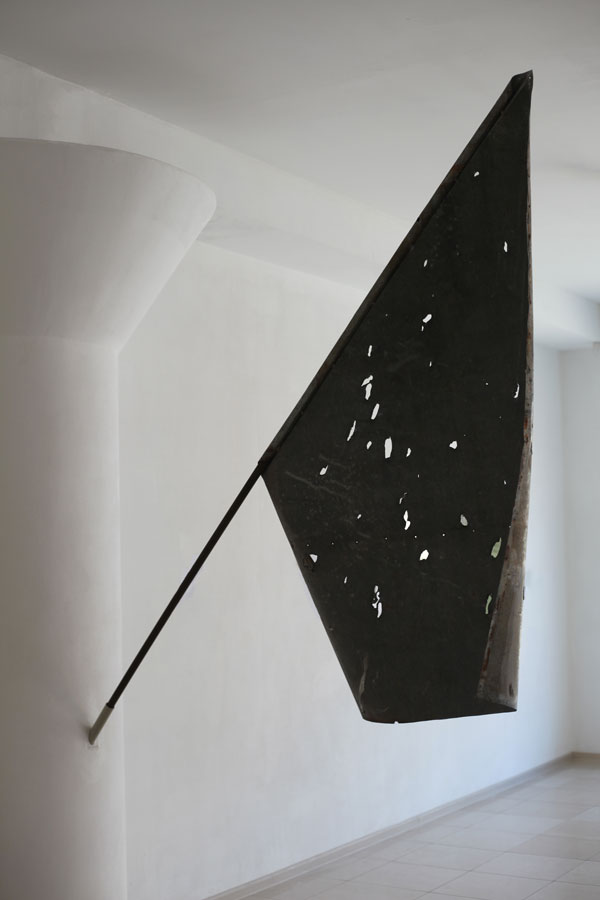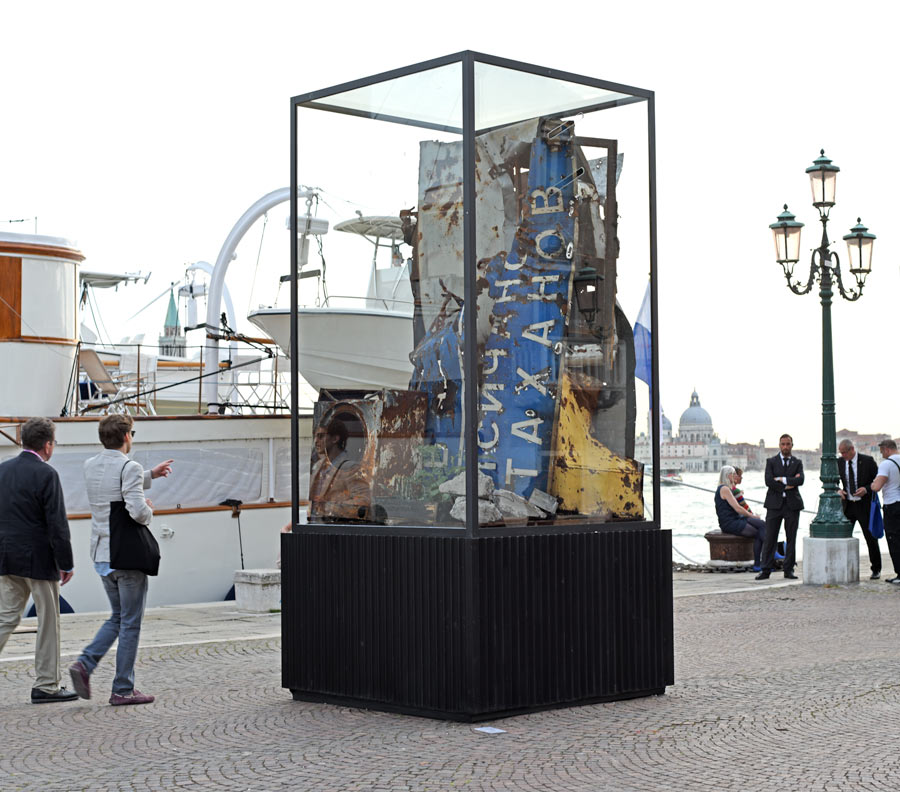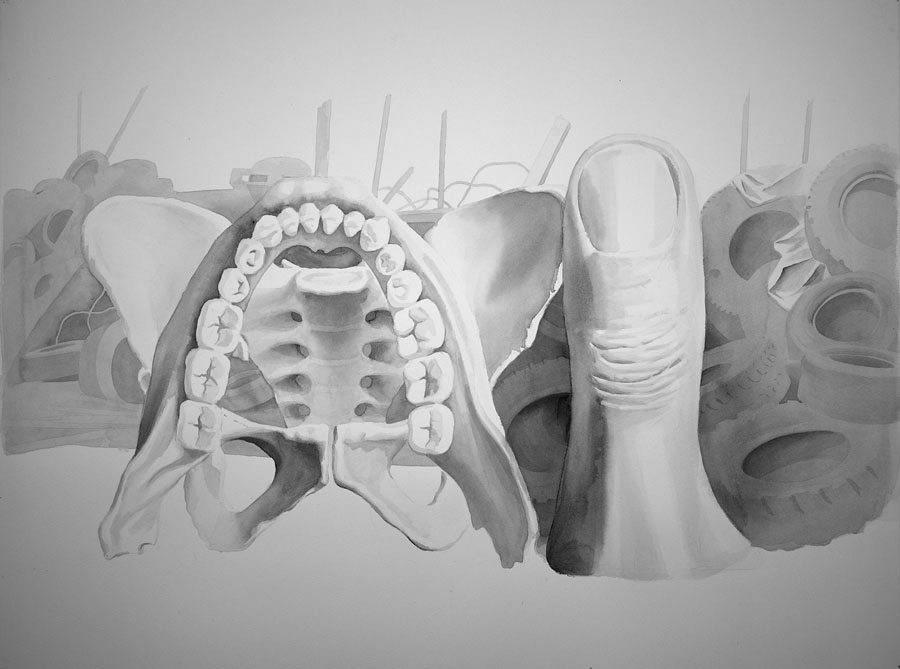zandpoortvest 10
be 2800 mechelen
t +32 15 336 336
m (b) +32 478 811 441
m (d) +32 475 477 478
Nikita Kadan | The Beautiful Colonizer | 09.02 - 15.03.2020 | open: Friday, Saturday & Sunday 2-6 pm
New paintings, charcoal drawings and collages by Nikita Kadan are based on combining images which relate to three different thematic fields: fate of socialist monuments in Ukraine, destroyed during 'decommunisation politics' period which started in 2014; Ukrainian avant-garde art of 1920th and current debates about it's 'national' and 'universalist' interpretations; collective rituals of Ukrainian youth, including nationalist torchlid marches and cosmopolitain techno parties in Kyiv. Combining different visual technics and overlapping different types of images (quoted from chronicles of Ukrainian social life, from past and current political propaganda and from art history) Kadan describes complicated relations between post-Soviet rethinking of XX century experiences and zones of collective amnesia, between internationalism and nationalism, between historical and contemporary. One of central questions posed by 'The Beautiful Colonizer' is whether one can speak about the Soviet period of Ukrainian history as 'colonization' and how relevant is to look at the post-Soviet contemporaniety of the country through post-colonial lenses.
According to Katerina Gregos 'Nikita Kadan's work poignantly navigates the complicated terrain between different political ideologies, transcending their one-dimensional definitions of utopia or dystopia in order to examine the repercussions of their practices with a more objective eye. At the same time, his practice exercises a critique of the neocapitalist order that has come to replace socialist ideals and values in former Soviet countries – however flawed – that left behind a social vacuum that still remains to be filled'*.
The film "Documenting Cxema" by Yarema Malashchuk and Roman Himey dedicated to the biggest Rave in Ukraine will be shown as an intervention to exhibition in dialogue with the works of Nikita Kadan.
*Katerina Gregos, 'On the Politics of Transformation', 2015
From 'Nikita Kadan. Yesterday, Today, Today', edited by Transit gallery, Mechelen, 2015
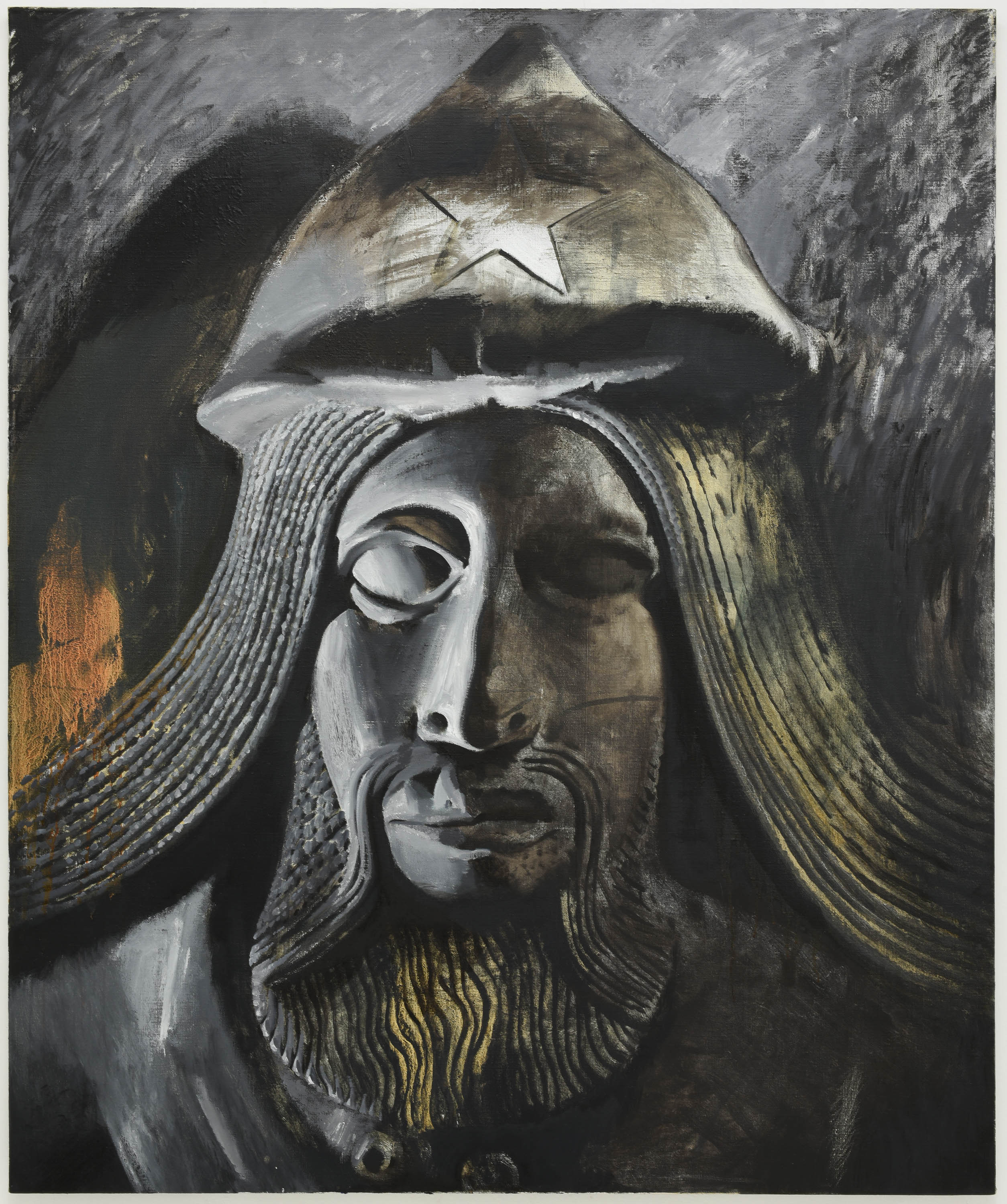 The Beautiful Colonizator, 2020, oil on canvas, 120 x 100 cm, collection Vlaamse Gemeenschap
The Beautiful Colonizator, 2020, oil on canvas, 120 x 100 cm, collection Vlaamse Gemeenschap
NL:
Nieuwe schilderijen, houtskooltekeningen en collages van Nikita Kadan zijn gebaseerd op het combineren van beelden die betrekking hebben op drie verschillende thematische gebieden: het lot van socialistische monumenten in Oekraïne, vernietigd tijdens de periode van de 'decommunisatiepolitiek' die begon in 2014; Oekraïense avant-garde kunst van 1920 en de huidige debatten over de 'nationale' en 'universalistische' interpretaties ervan; collectieve rituelen van Oekraïense jongeren, waaronder nationalistische fakkelmarsen en kosmopolitische techno-parties in Kiev. Door het combineren van verschillende visuele technieken en het overlappen van verschillende soorten beelden (geciteerd uit kronieken van het Oekraïense sociale leven, uit vroegere en huidige politieke propaganda en uit de kunstgeschiedenis) beschrijft Kadan complexe relaties tussen de post-Sovjet heroverweging van XX eeuwse ervaringen en zones van collectief geheugenverlies, tussen internationalisme en nationalisme, tussen historisch en hedendaags. Een van de centrale vragen die 'The Beautiful Colonizer' oproept, is of men de Sovjetperiode van de Oekraïense geschiedenis kan omschrijven als 'kolonisatie' en hoe relevant het is om de post-Sovjet hedendaagsheid van het land te bekijken door middel van postkoloniale lenzen.
Volgens Katerina Gregos navigeert 'Nikita Kadan's werk schrijnend op het ingewikkelde terrein tussen verschillende politieke ideologieën, waarbij ze hun eendimensionale definities van utopie of dystopie overstijgen om de gevolgen van hun praktijken met een objectiever oog te onderzoeken. Tegelijkertijd oefent zijn praktijk een kritiek uit op de neokapitalistische orde die in de plaats is gekomen van de socialistische idealen en waarden in de voormalige Sovjetlanden - hoe gebrekkig ook - die een sociaal vacuüm hebben achtergelaten dat nog moet worden opgevuld'*.
De film "Documenting Cxema" van Yarema Malashchuk en Roman Himey gewijd aan de tot nu toe grootste 'rave' in Oekraïne wordt getoond als interventie bij de tentoonstelling in dialoog met het werk van Nikita Kadan.
*Katerina Gregos, 'On the Politics of Transformation', 2015
Van 'Nikita Kadan. Yesterday, Today, Today', uitgegeven door galerie Transit, Mechelen, 2015.
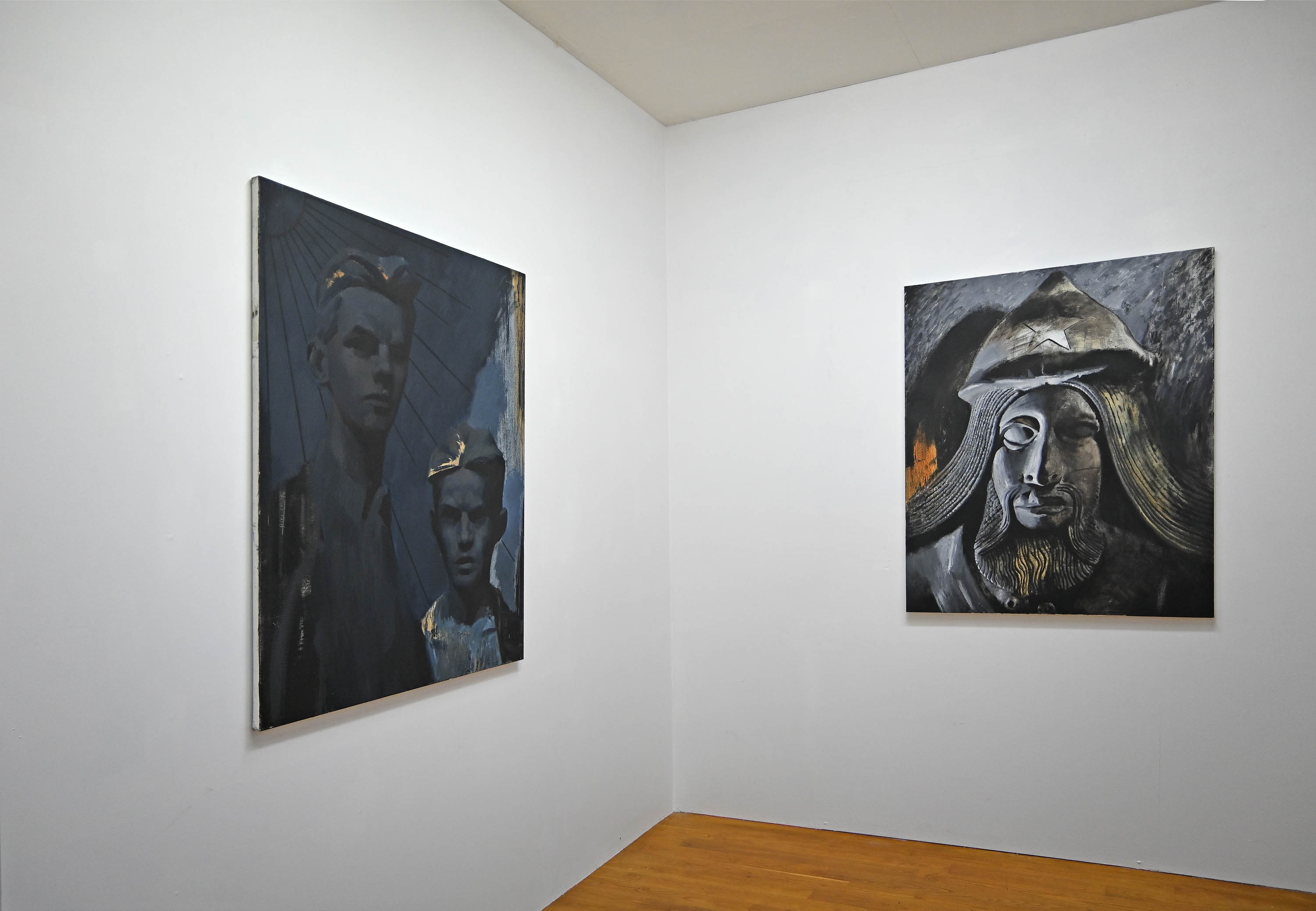
FR:
Les nouvelles peintures, dessins au fusain et collages de Nikita Kadan sont basés sur la combinaison d'images qui se rapportent à trois domaines thématiques différents : le destin des monuments socialistes en Ukraine, détruits pendant la période de " politique de décommunisation " qui a commencé en 2014 ; l'art d'avant-garde ukrainien des années 1920 et les débats actuels sur ses interprétations " nationales " et " universalistes " ; les rituels collectifs de la jeunesse ukrainienne, y compris les marches aux flambeaux nationalistes et les partis techno cosmopolites à Kiev. En combinant différentes techniques visuelles et en superposant différents types d'images (citées des chroniques de la vie sociale ukrainienne, de la propagande politique passée et actuelle et de l'histoire de l'art), Kadan décrit les relations compliquées entre la repensée post-soviétique des expériences du XXe siècle et les zones d'amnésie collective, entre l'internationalisme et le nationalisme, entre l'historique et le contemporain. L'une des questions centrales posées par " Le beau colonisateur " est de savoir si l'on peut parler de la période soviétique de l'histoire ukrainienne comme d'une " colonisation " et s'il est pertinent de considérer la contemporanéité post-soviétique du pays à travers des perspectives post-coloniales.
Selon Katerina Gregos, " le travail de Nikita Kadan navigue de manière poignante sur le terrain compliqué entre différentes idéologies politiques, transcendant leurs définitions unidimensionnelles de l'utopie ou de la dystopie afin d'examiner les répercussions de leurs pratiques avec un œil plus objectif. En même temps, sa pratique exerce une critique de l'ordre néocapitaliste qui est venu remplacer les idéaux et les valeurs socialistes dans les pays de l'ex-Union soviétique - aussi imparfaits soient-ils - qui ont laissé derrière eux un vide social qui reste à combler "*.
Le film "Documenting Cxema" de Yarema Malashchuk et Roman Himey consacré à la plus grande Rave d'Ukraine sera présenté comme une intervention à l'exposition en dialogue avec les œuvres de Nikita Kadan.
*Katerina Gregos, "On the Politics of Transformation", 2015
De Nikita Kadan. Yesterday, Today, Today', édité par la galerie Transit, Malines, 2015
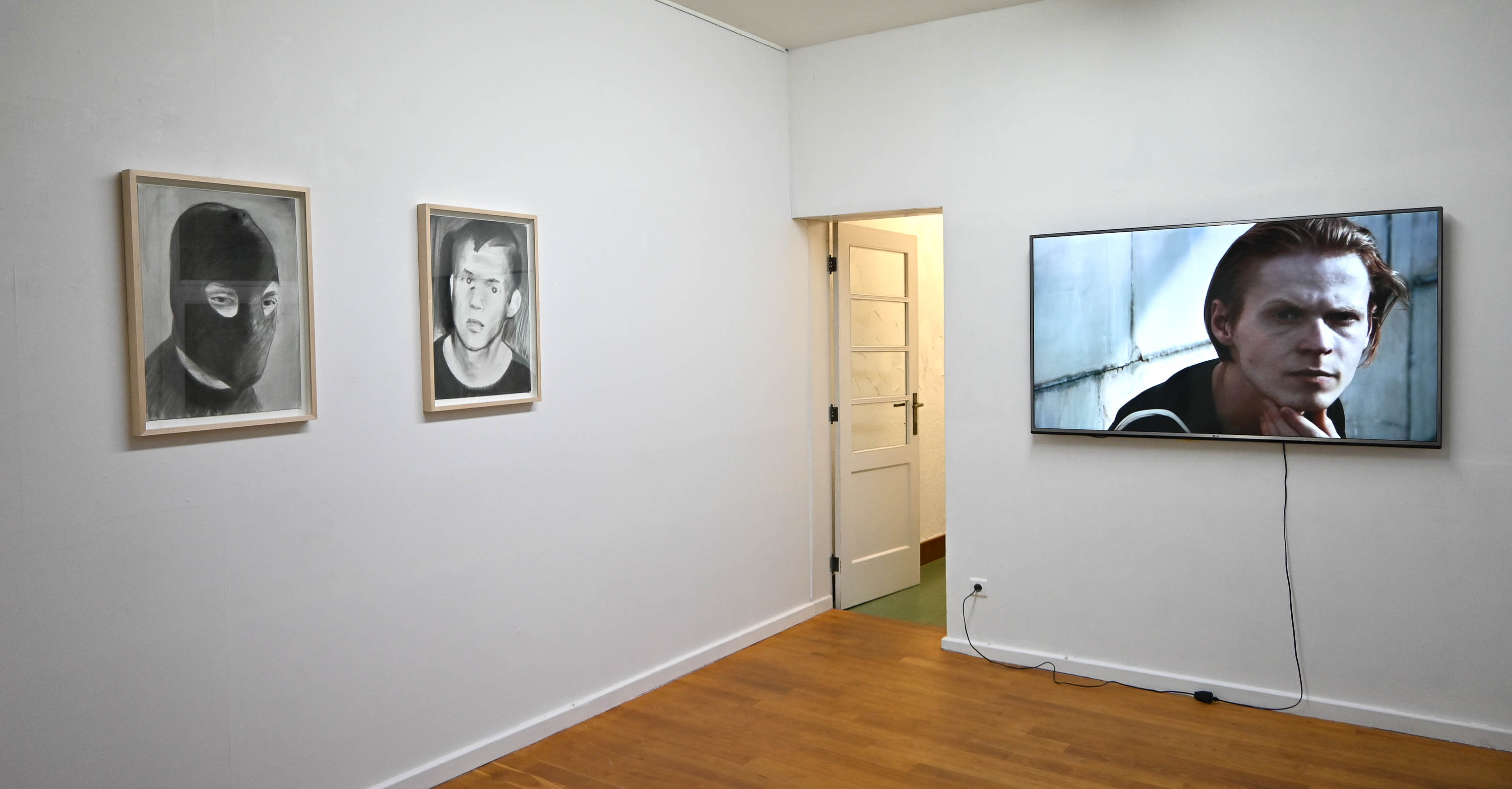
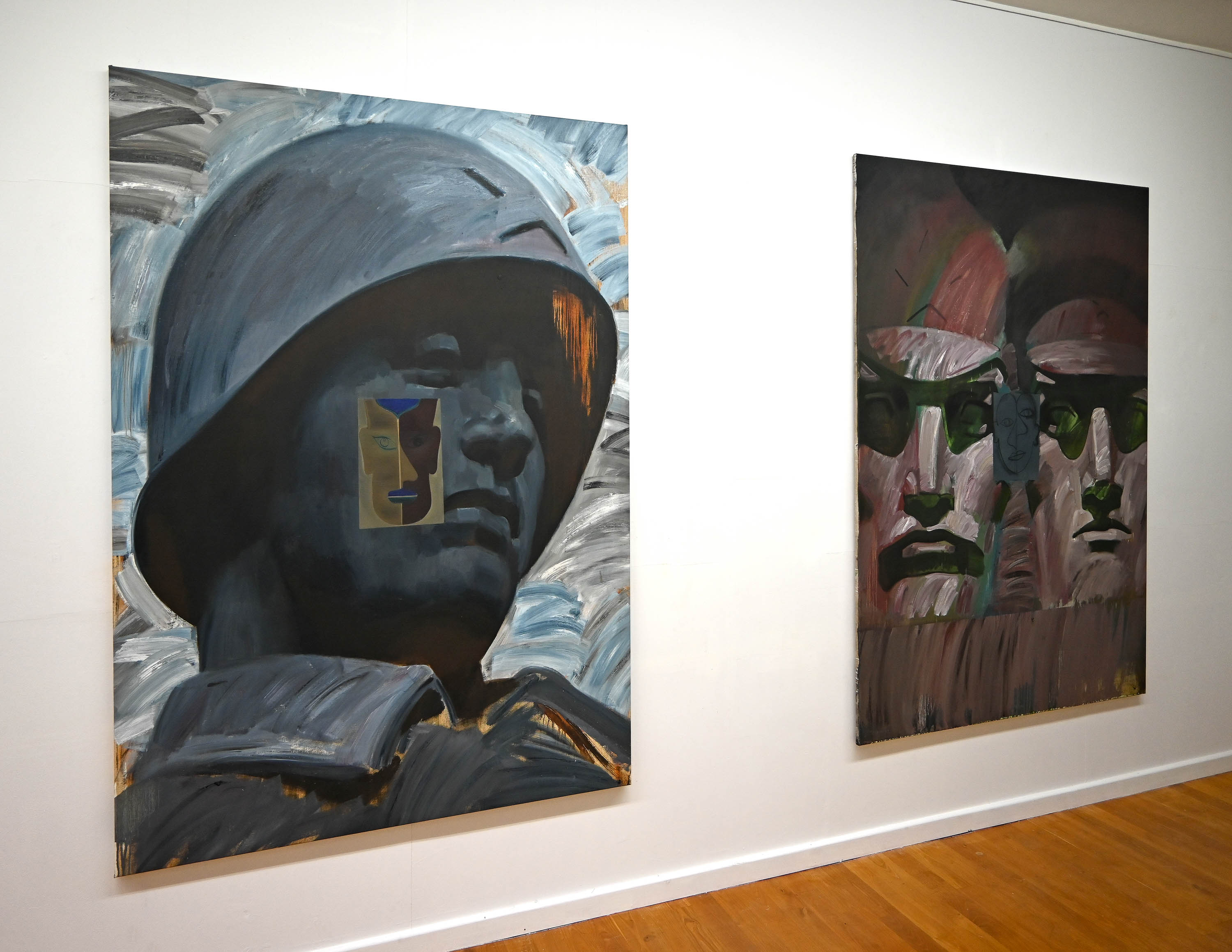 Poet I & III
Poet I & III
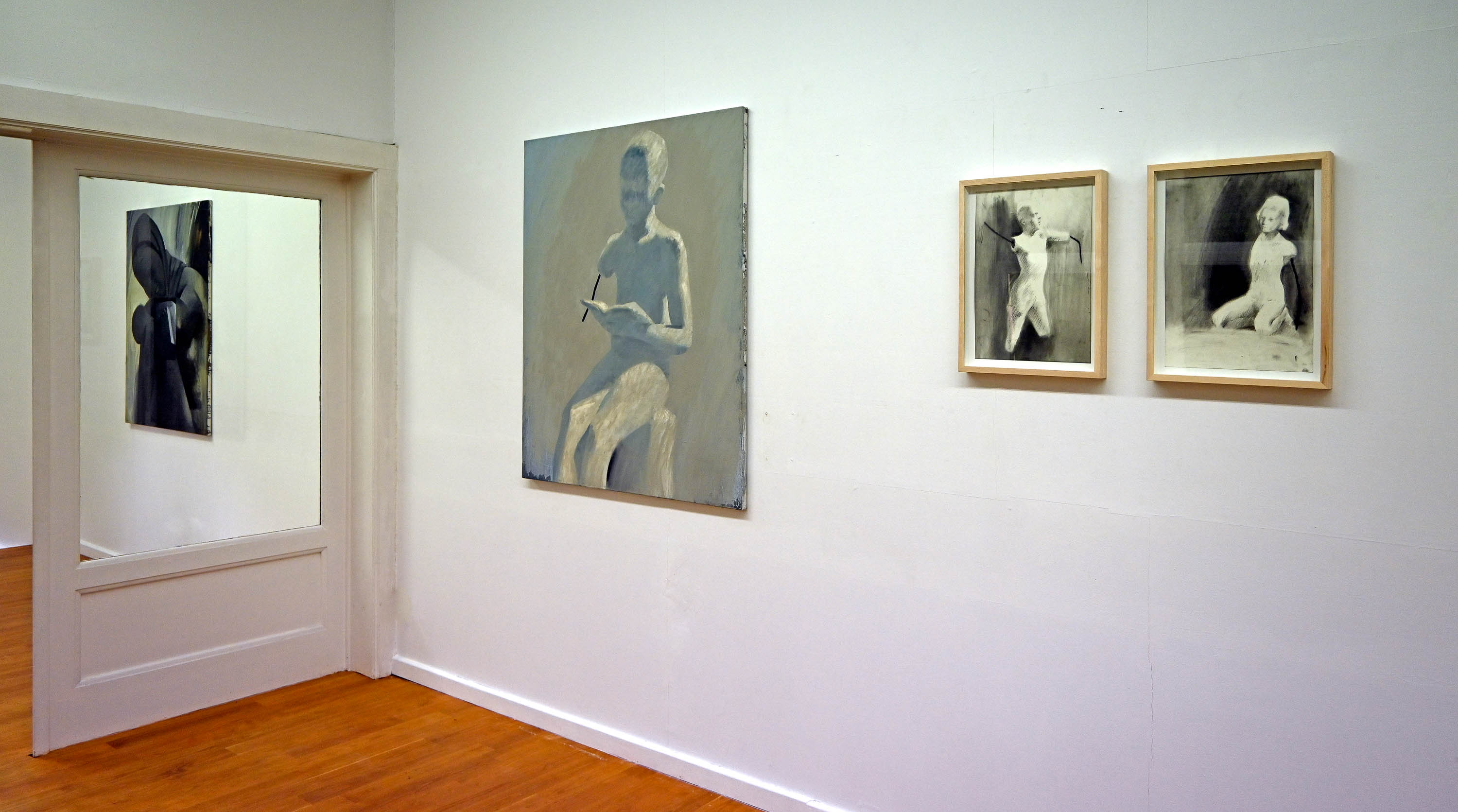
WORKS IN THE EXHIBITION:
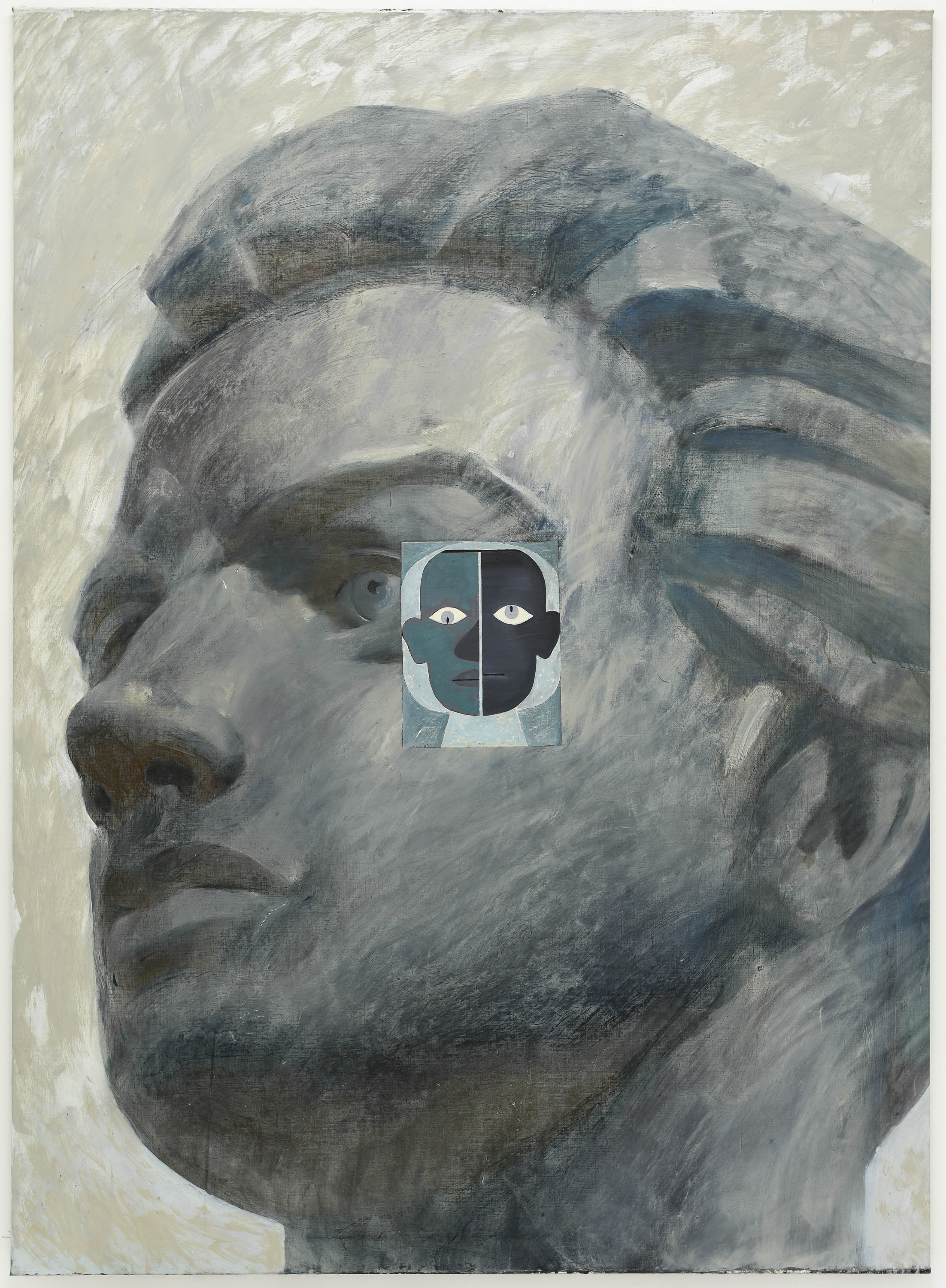 Poet II, 2020, oil on canvas, 200 x 145 cm, 5.700 €
Poet II, 2020, oil on canvas, 200 x 145 cm, 5.700 €
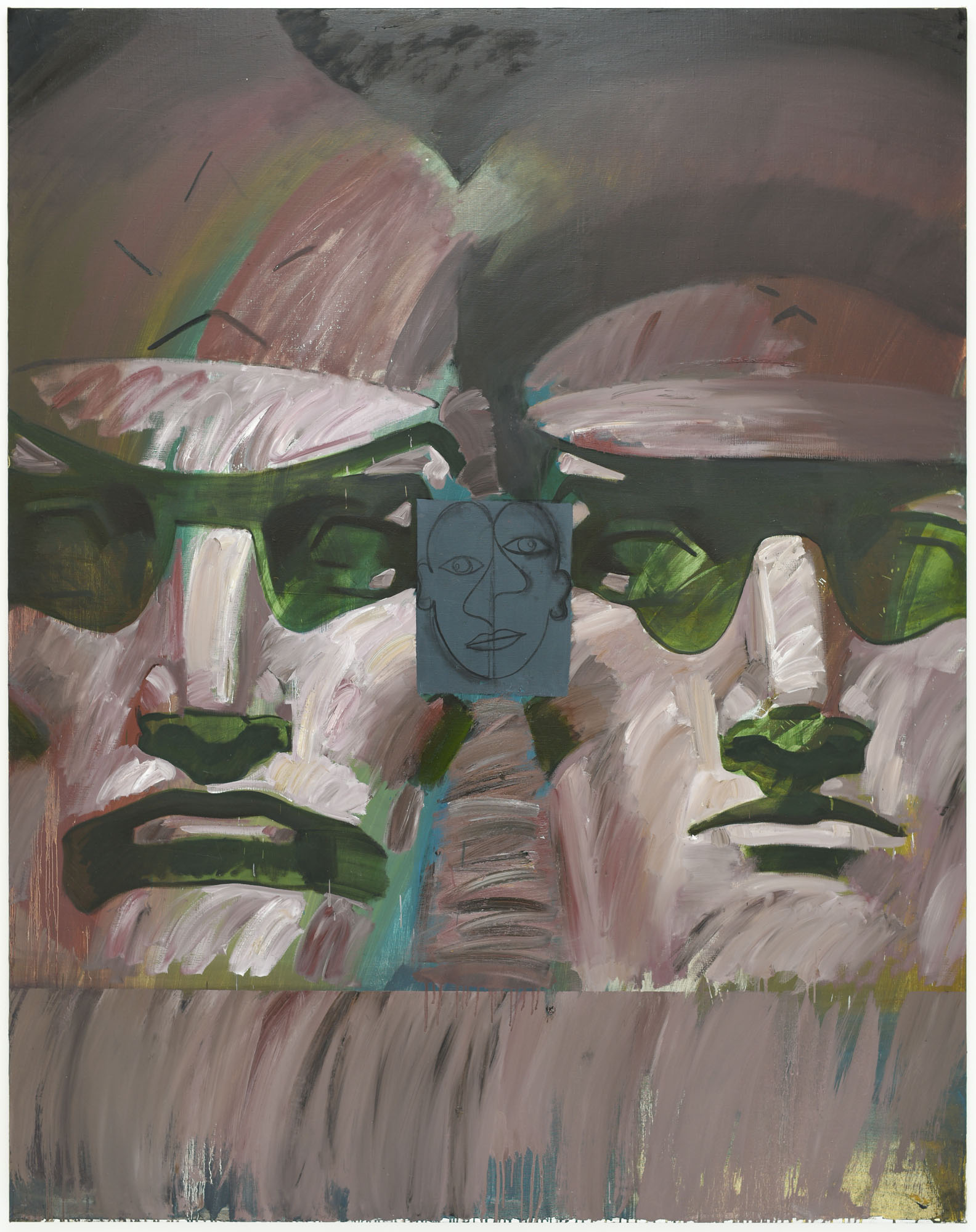 Poet III, 2020, oil on canvas, 190 x 150 cm, private collection
Poet III, 2020, oil on canvas, 190 x 150 cm, private collection
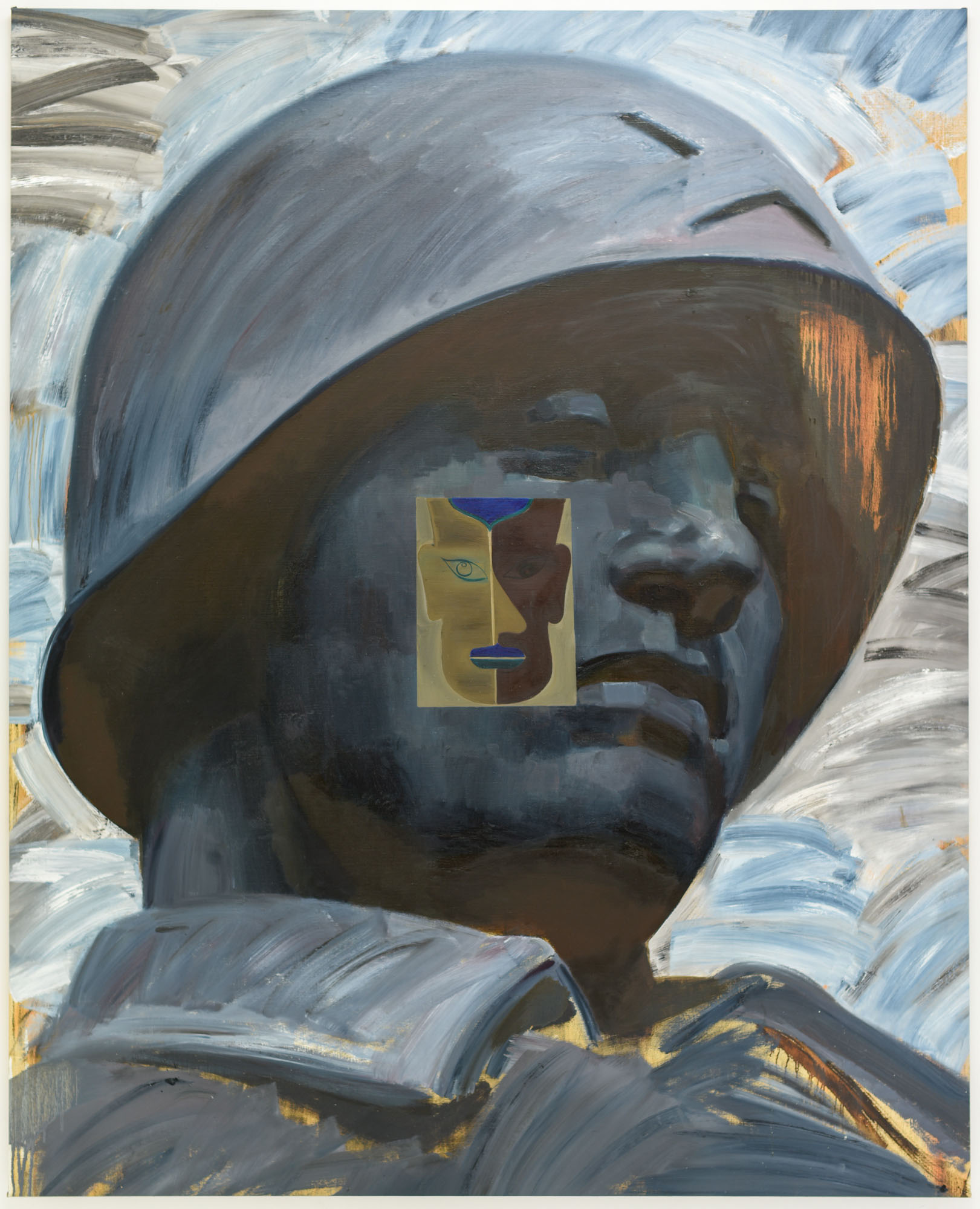 Poet I, 2020, oil on canvas, 190 x 150 cm, 5.700 €
Poet I, 2020, oil on canvas, 190 x 150 cm, 5.700 €
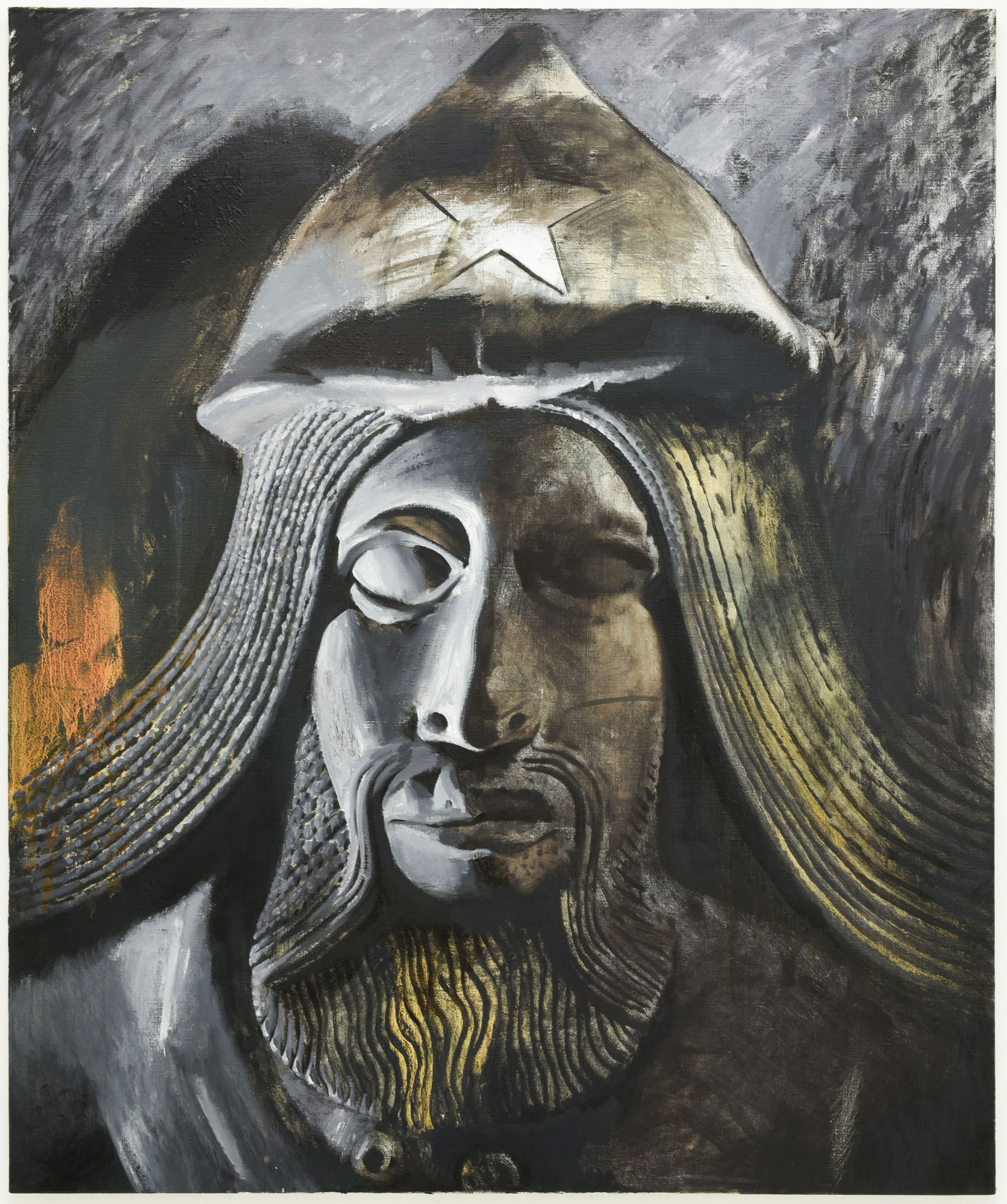 The Beautiful Colonizer, 2020, oil on canvas, 120 x 100 cm, collection Vlaamse Gemeenschap
The Beautiful Colonizer, 2020, oil on canvas, 120 x 100 cm, collection Vlaamse Gemeenschap
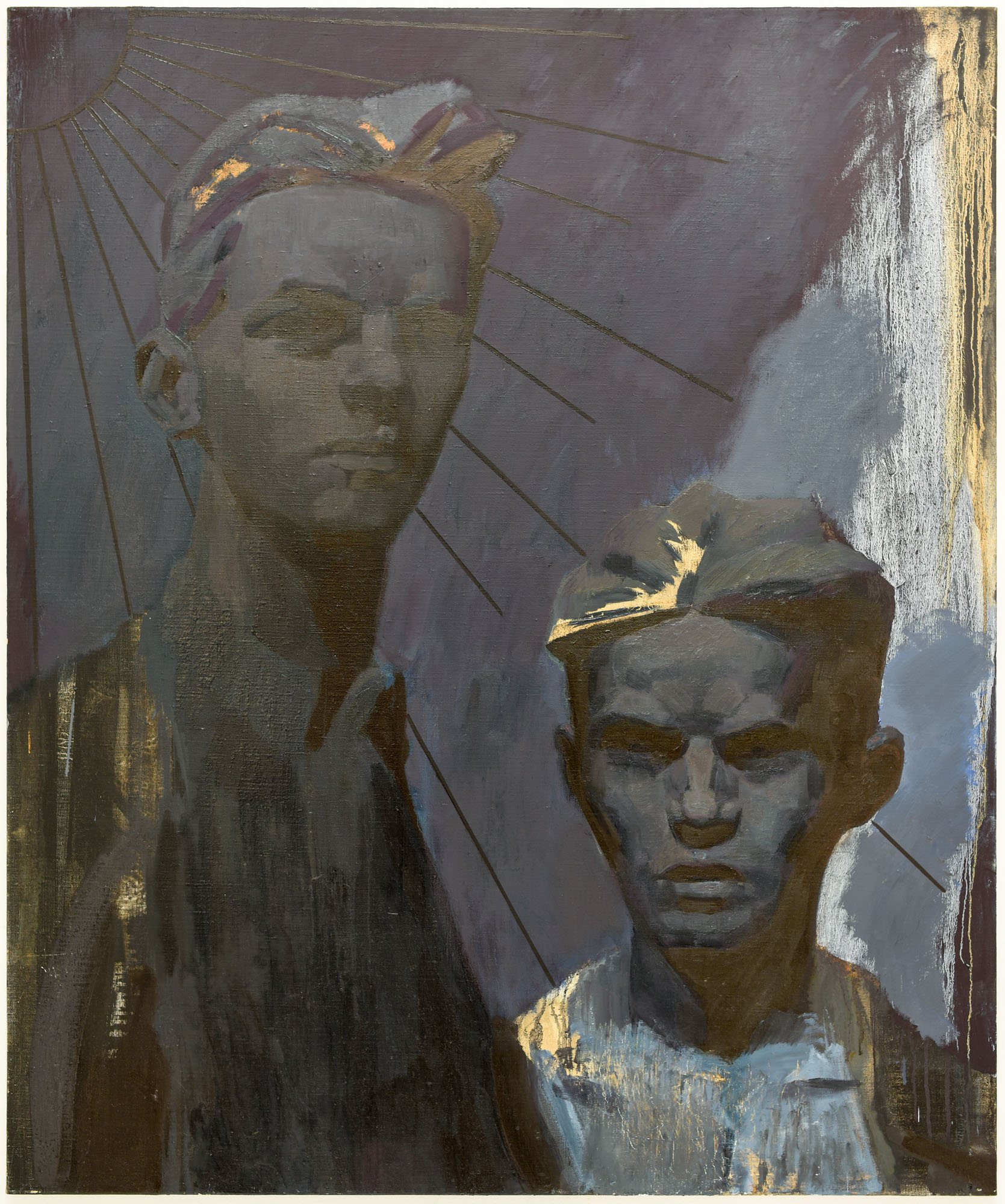 Partisan Boys, 2020, oil on canvas, 120 x 100 cm, private collection
Partisan Boys, 2020, oil on canvas, 120 x 100 cm, private collection
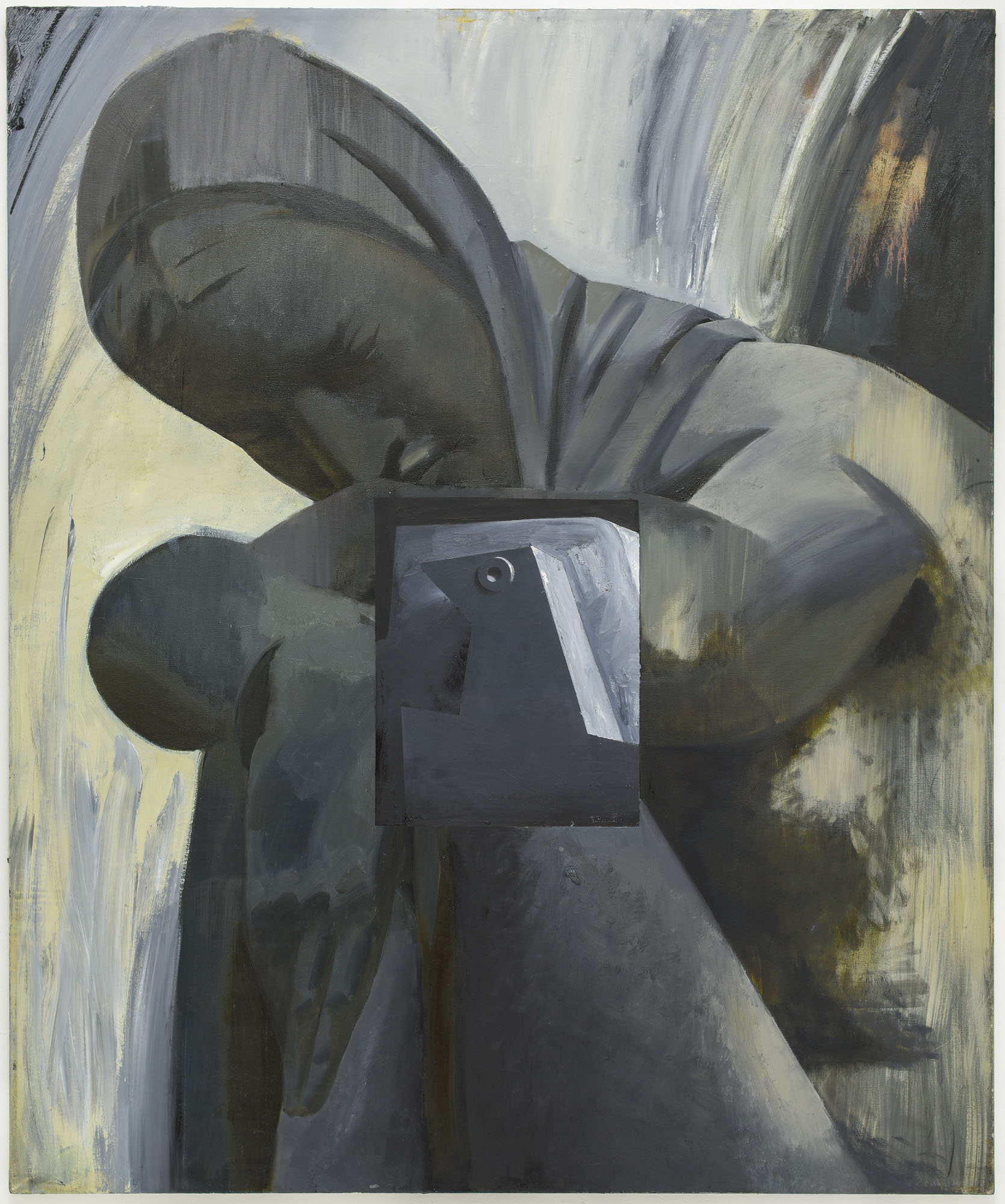 To the Victims of Fascism, 2020, oil on canvas, 120 x 100 cm, 4.700 €
To the Victims of Fascism, 2020, oil on canvas, 120 x 100 cm, 4.700 €
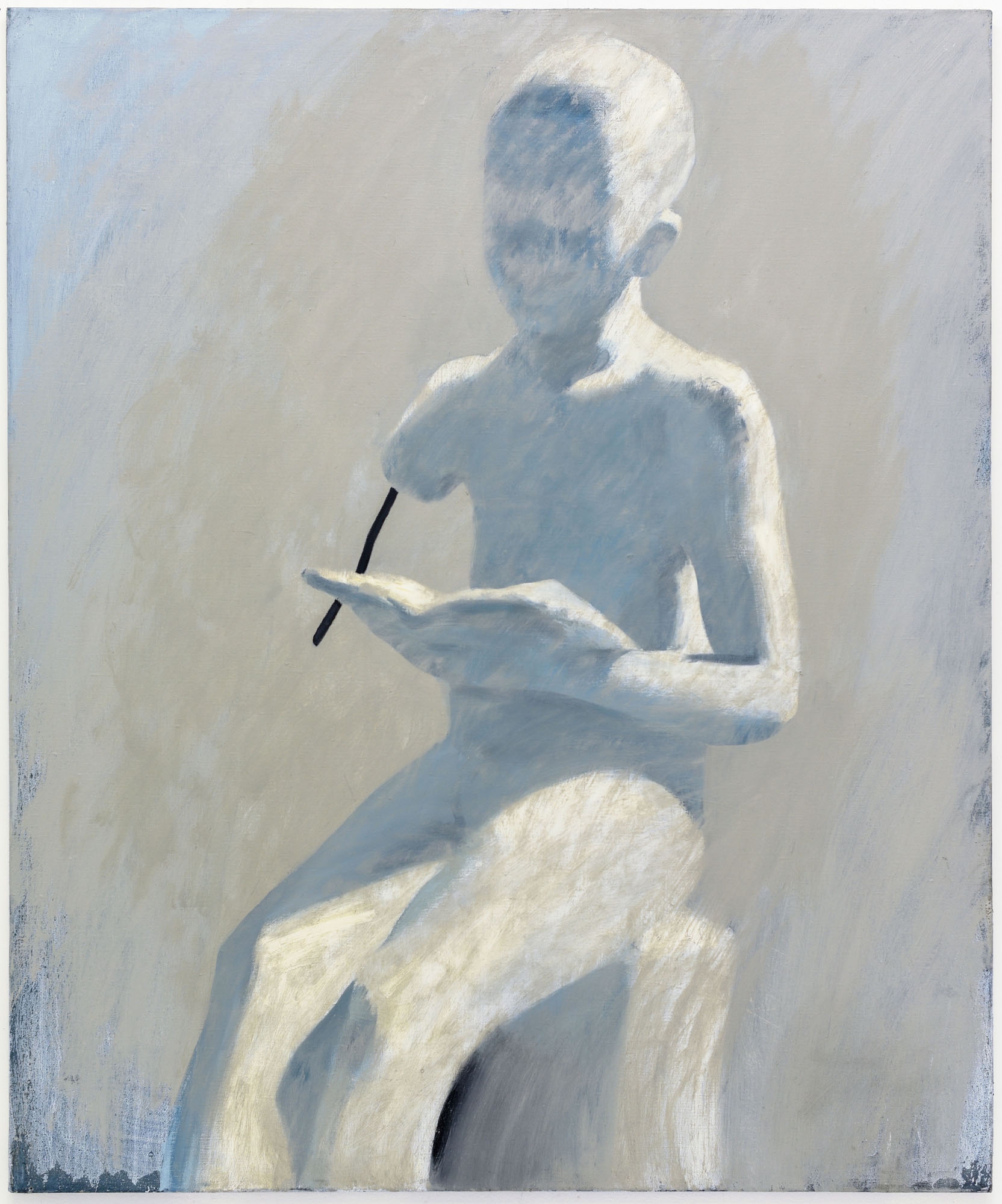 The Reading Boy, 2020, oil on canvas, 120 x 100 cm, private collection
The Reading Boy, 2020, oil on canvas, 120 x 100 cm, private collection
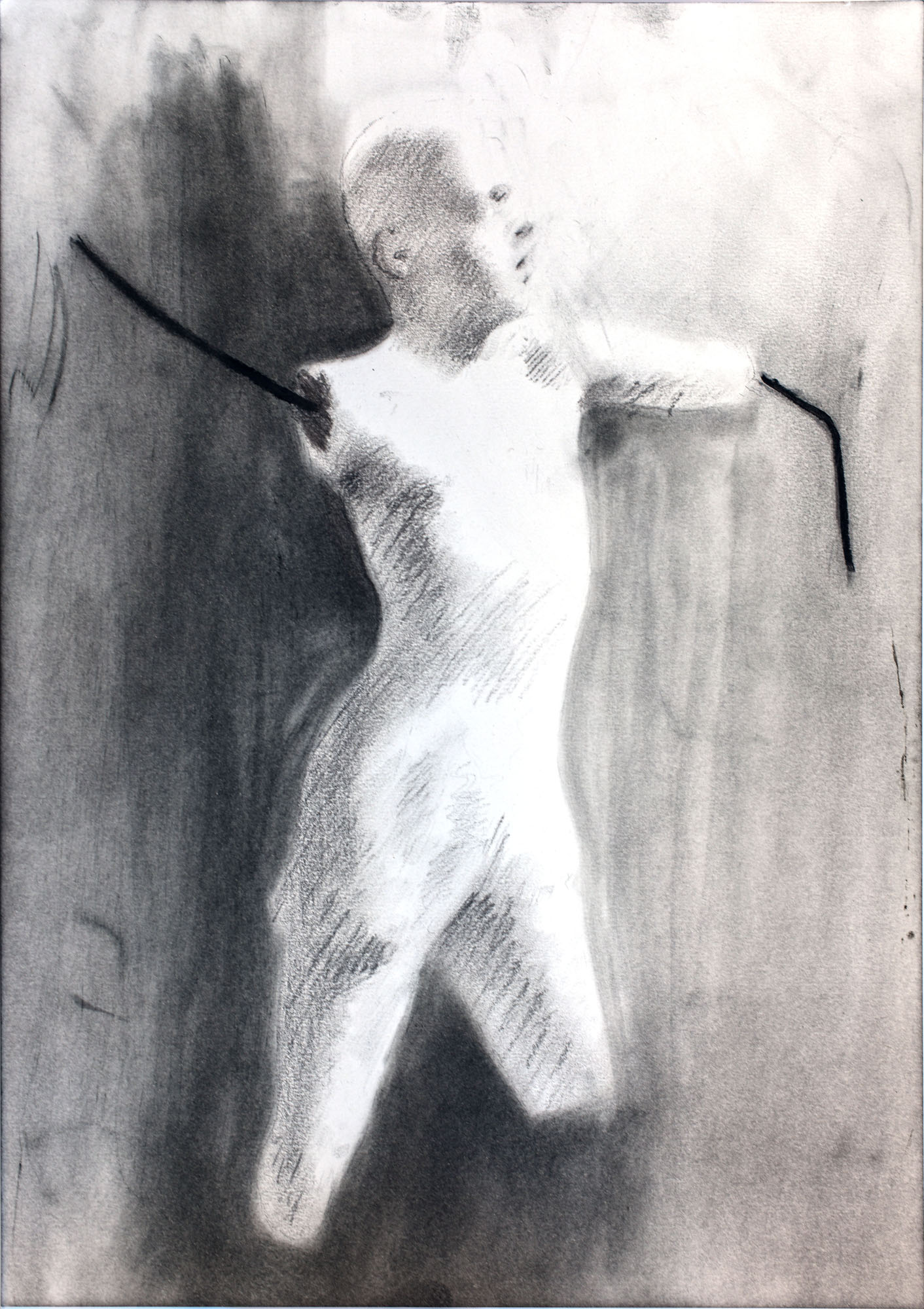
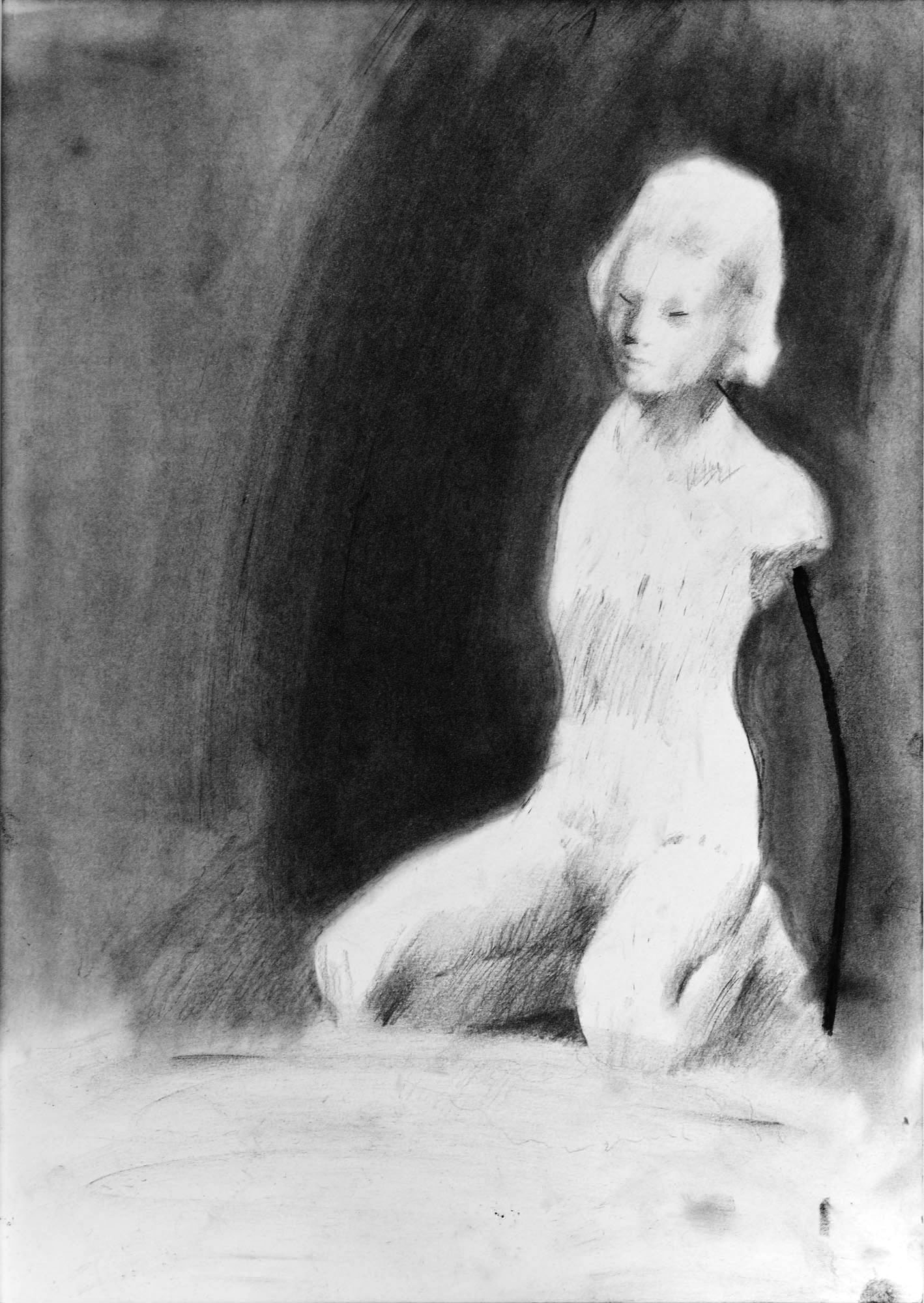 Park Pioneer 1 & 2, 2020, charcoal on paper, 42 x 29 cm, 1.500 € each
Park Pioneer 1 & 2, 2020, charcoal on paper, 42 x 29 cm, 1.500 € each
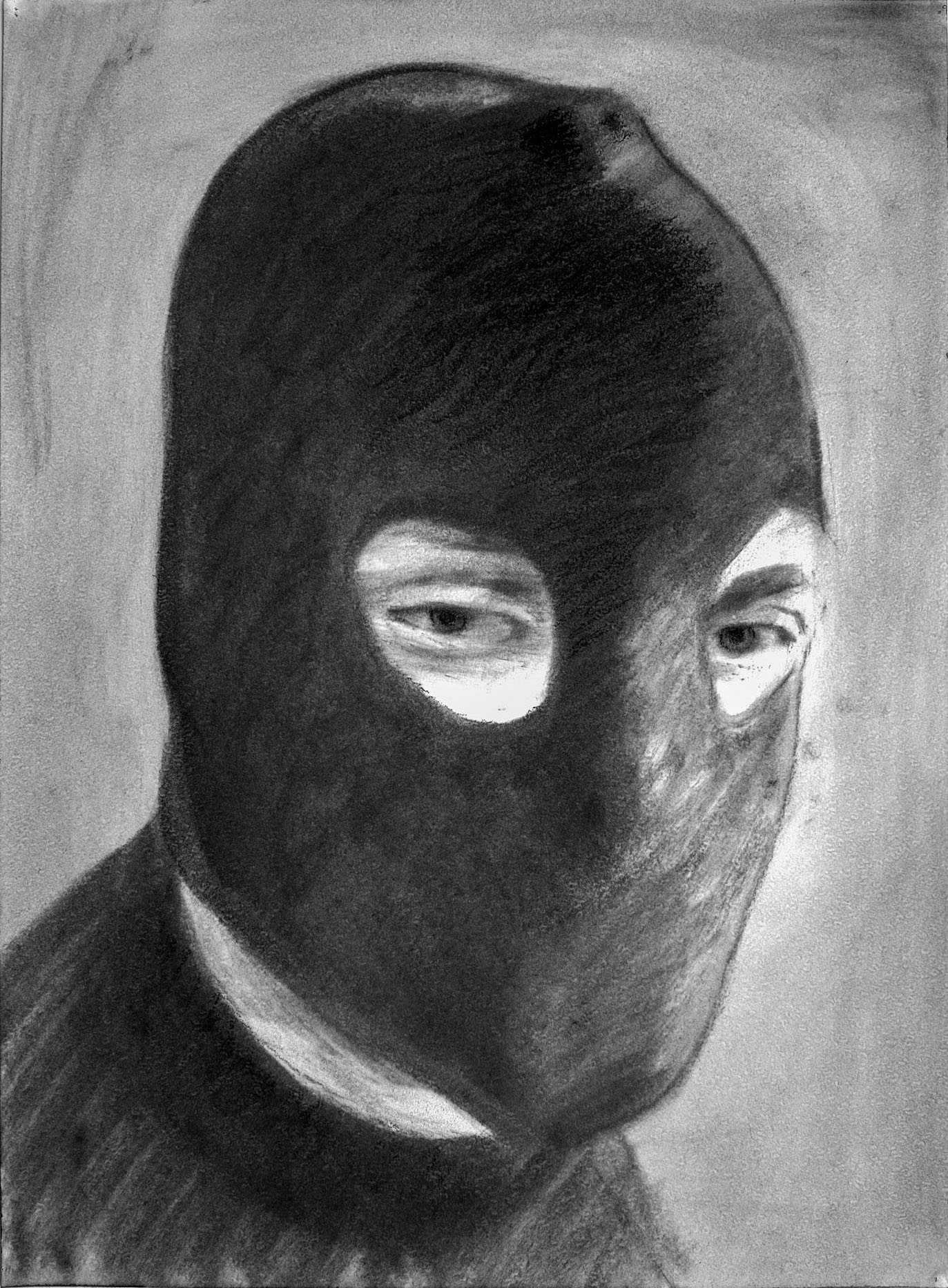
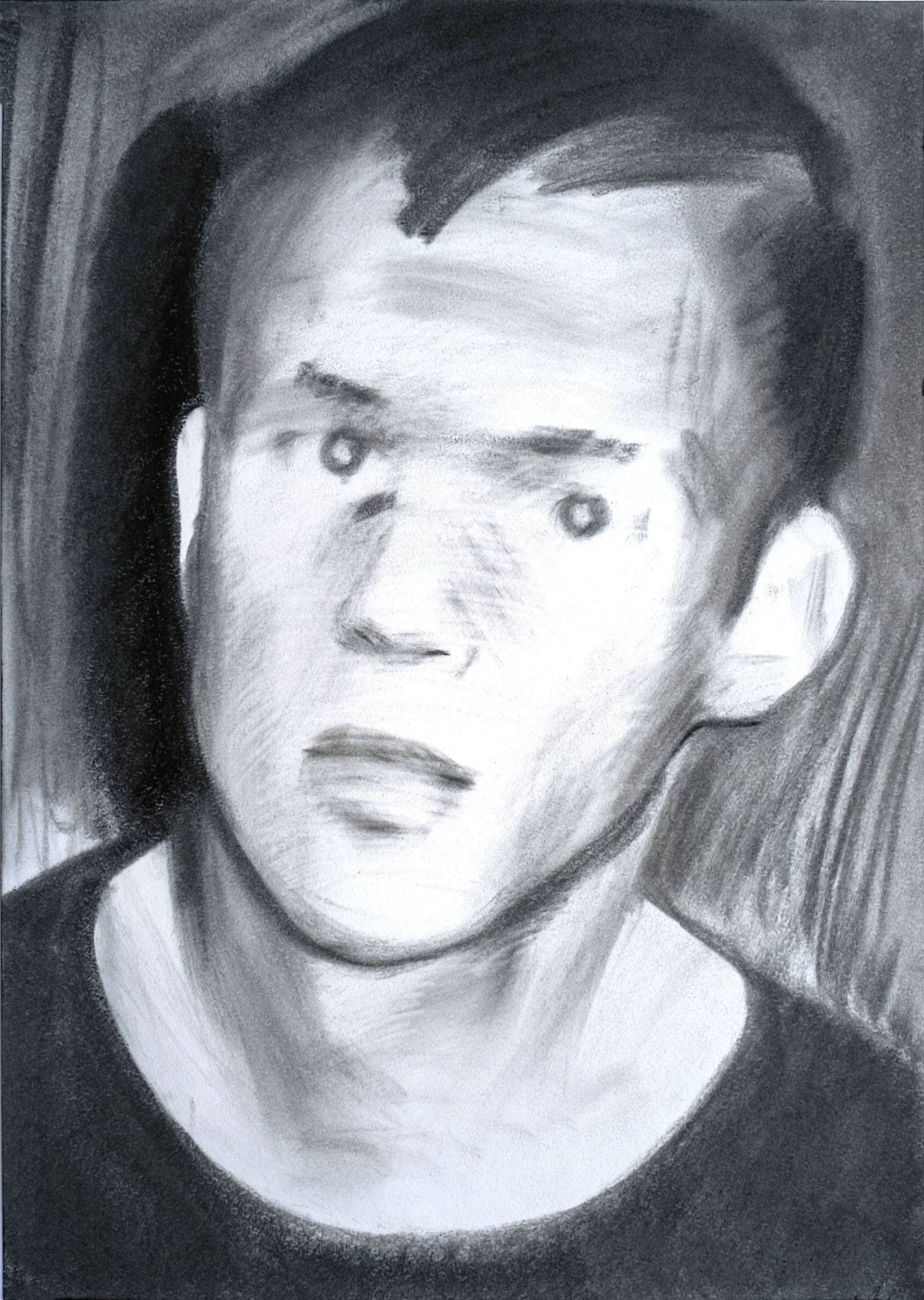
left: The March [Torchlid Marche], 2020, charcoal on paper, 60 x 42 cm & right: The Mask, 2020, charcoal on paper, 60 x 42 cm, 1.500 € each
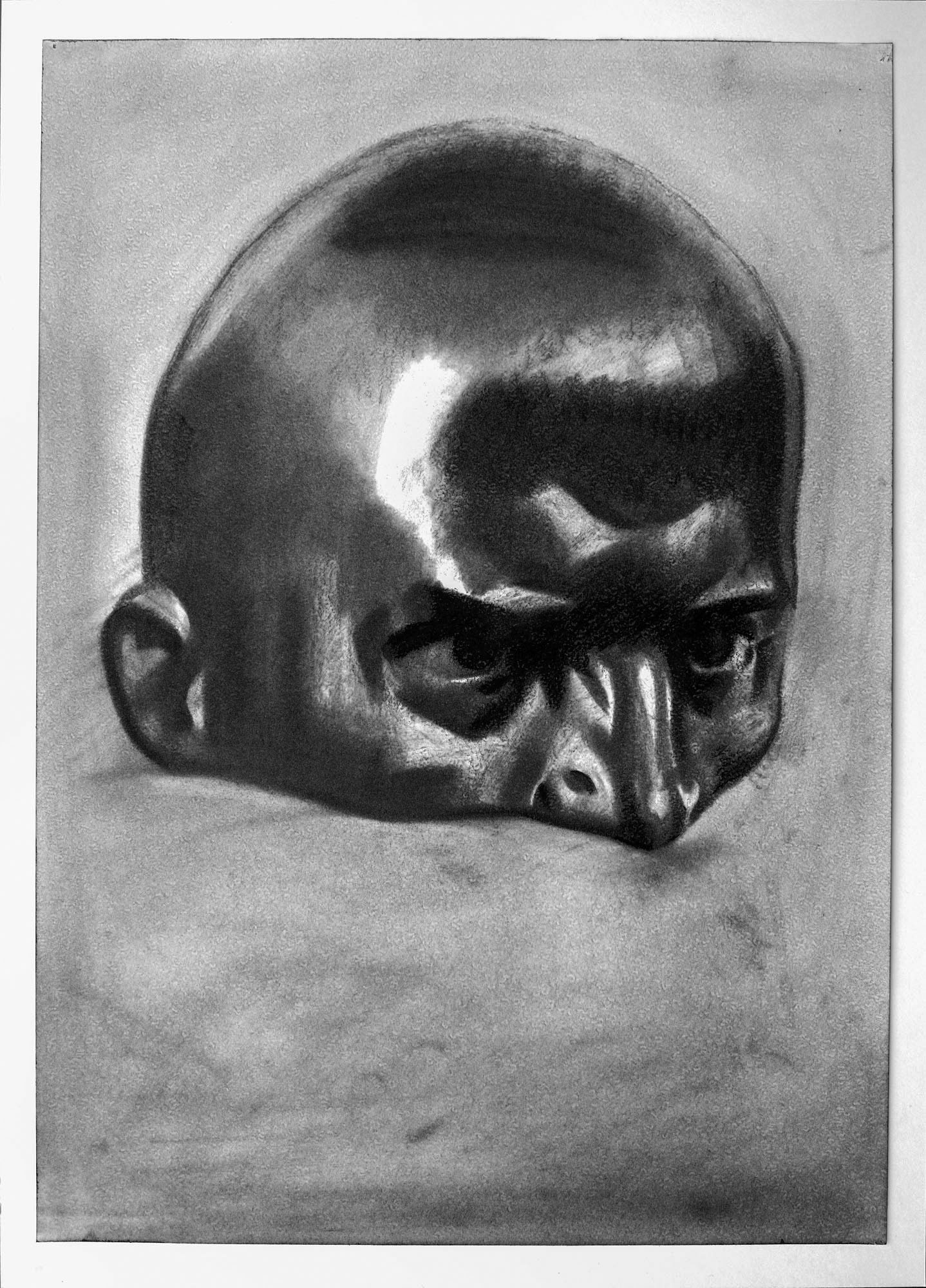
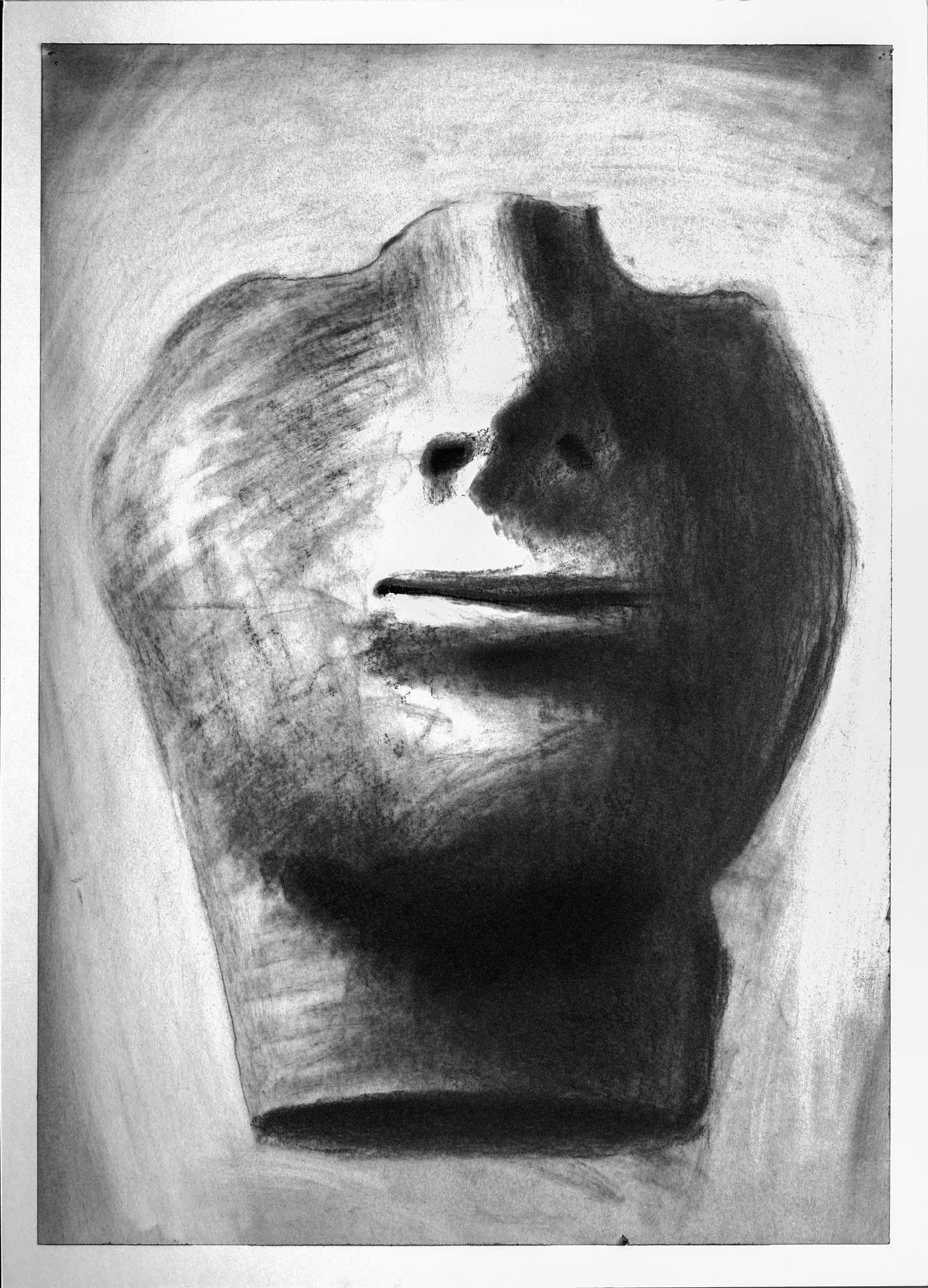
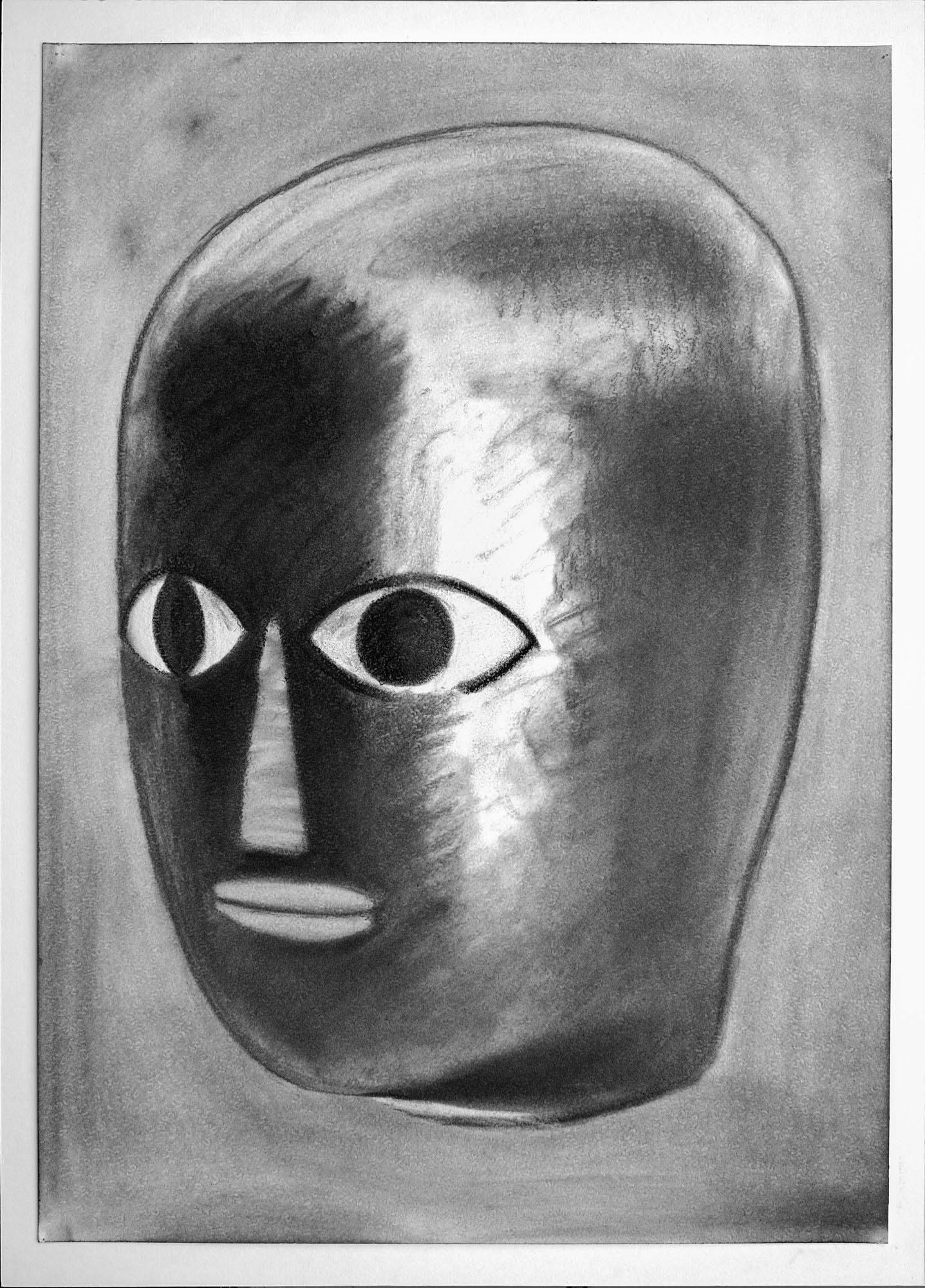
left: The Mask [Lenin] | mid: The Mask | right: The Mask III [Oscar Schlemmer] | All: 2020, charcoal on paper, 60 x 42 cm, 1.500 € each
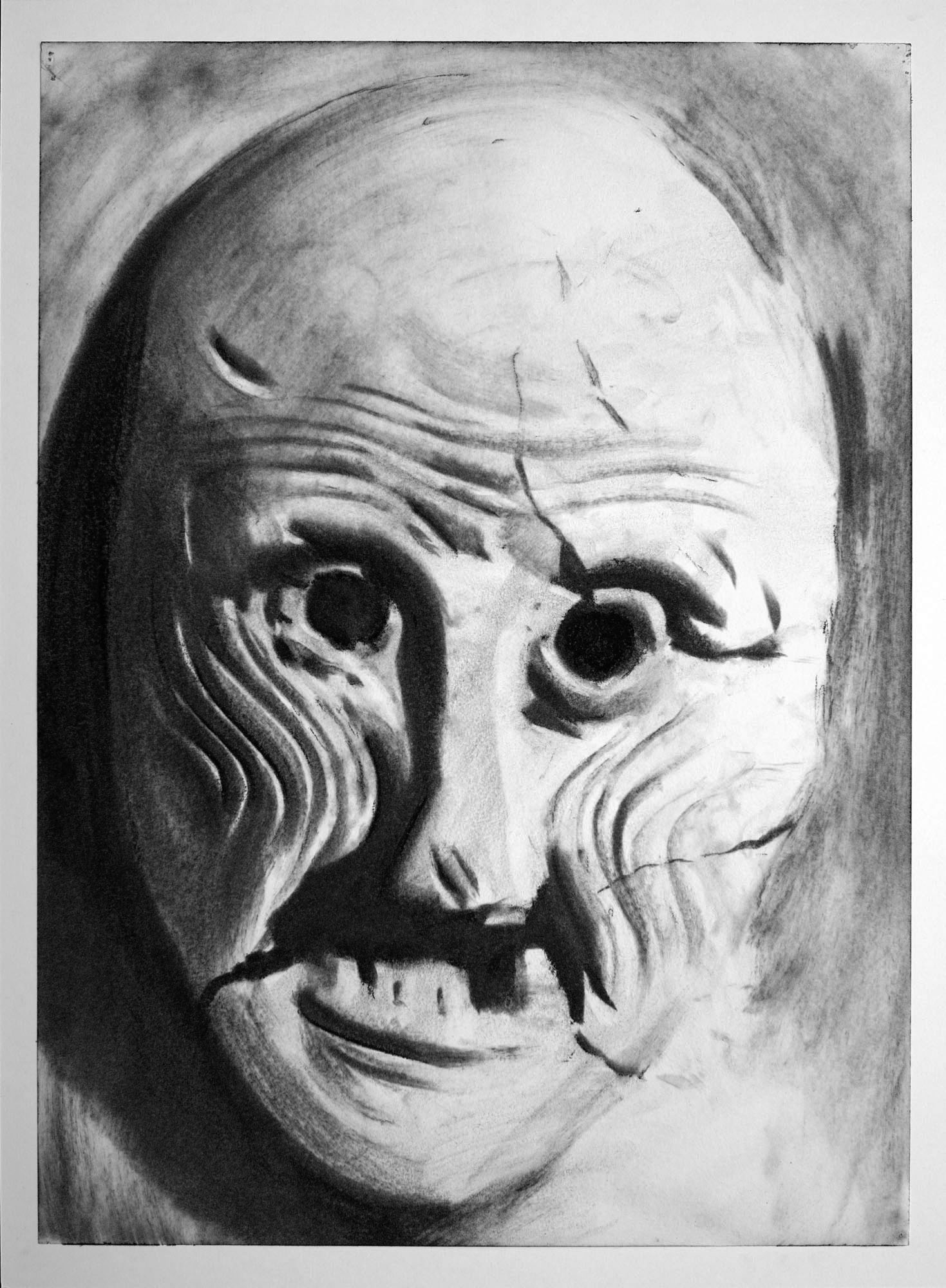
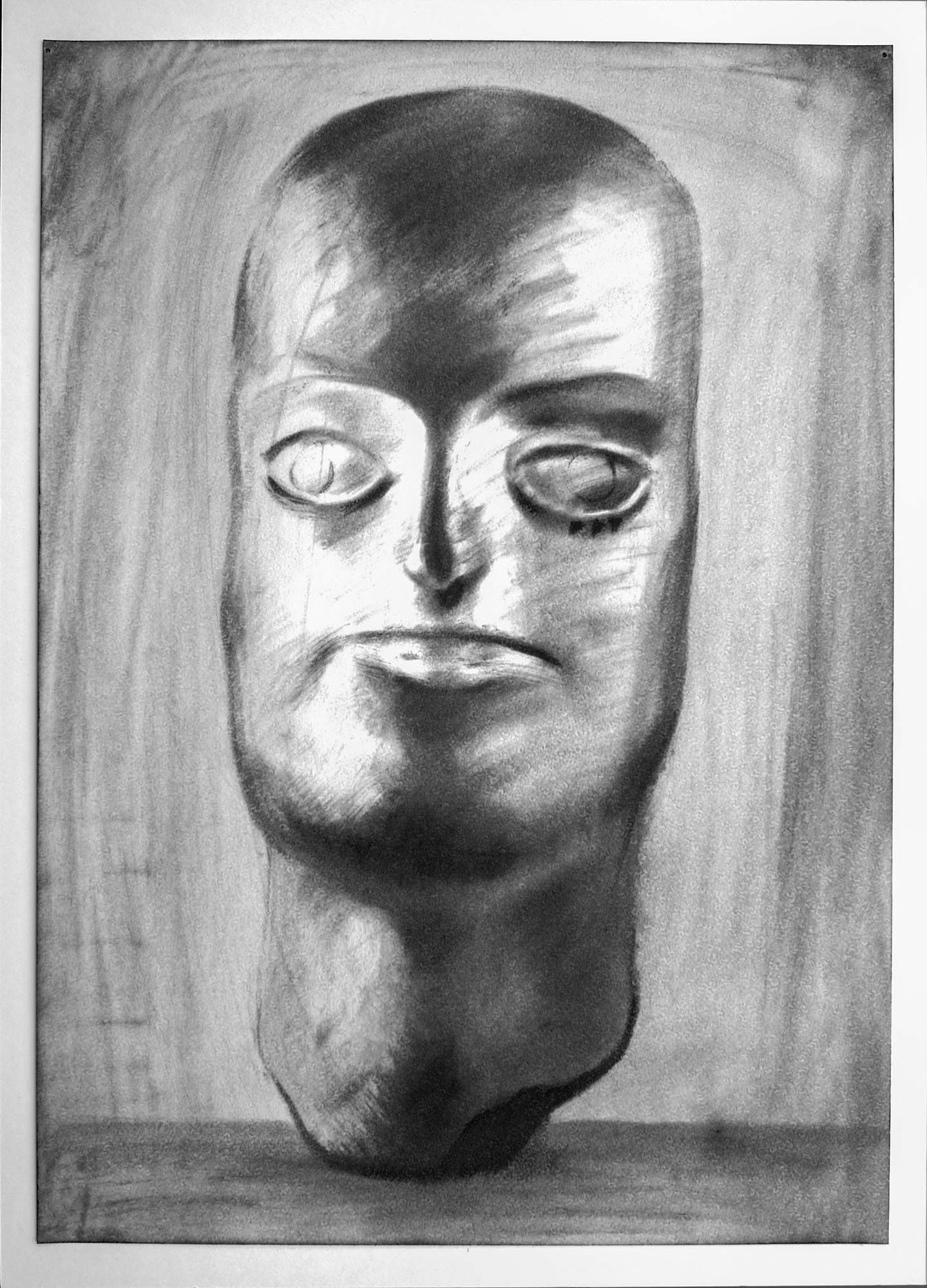
left: The Mask II [Demon], 2020, charcoal on paper, 60 x 42 cm & right: The Mask IV [Archipenko], 2020, charcoal on paper, 60 x 42 cm, 1.500 € each
Usti-nad-Labem, CZ, 2018
The work of Nikita Kadan combines an attempt to represent the continuous loss of a coherent historical narrative and an effort to re-establish the role of the artist and of the symbolic artistic representation in society. The attentive alignment of his practice to critical socio-political issues provides us with an insight into the political experience of the totalizing "now" characterizing the current situation in Ukraine. Emerging from a tradition of collective activism within the R.E.P. group, Kadan's individual practice has elaborated a body of works encompassing the notions of politics of memory and the relations between the narratives of modernity and the reality of capitalist society. A particular sensibility for the status of history and the ability to visualize the internal mechanisms that regulate the dynamics between forgetfulness and memory pervade his works. After the early post-Soviet period characterized by "historical amnesia," the last decade of Ukrainian history has been marked by a "war of memory," where contradictory historical symbols and judgments, corresponding to various political needs and cultural desires, populate the public mind. One of the predominant desires of post-Orange-Revolution Ukraine is identified with "Euro-renovation," an aspiration to construct a new European-Ukrainian identity by hiding anything that bears the weight of the past.
In the words of the artist: "Ukrainian Euro-renovation consists of replaceable surfaces, drywall and plastic. Euro-renovation is a self identification through consumption, an expensive spectacle of representative democracy rapidly deteriorating in meaning, the euphoria of an 'eternal today,' a plastic sheet of printed advertisement glued onto the granite of the Soviet metro".
Art Brussels 2018
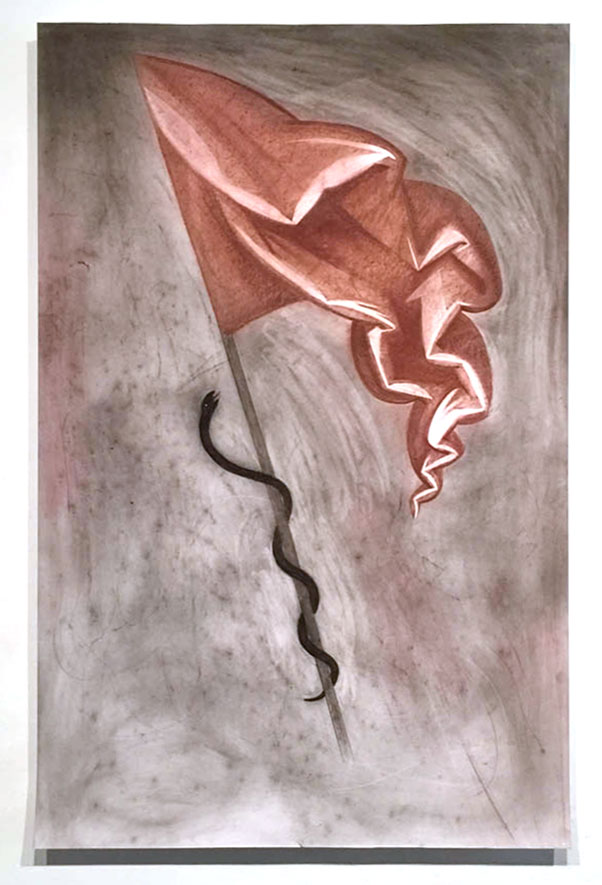
Serpent on a flag, 2016, charcoal on paper, 197 x 150 cm
High Disease | november - december 2017 | galerie Transit
De titel 'High Disease' van de derde tentoonstelling van Nikita Kadan in galerie Transit is ontleend aan een gedicht van Boris Pasternak. Het gedicht, dat Pasternak zelf 'het fragment' noemde, verwijst naar een revolutionair heldendicht.
Dit jaar, exact 100 jaar na de Oktoberrevolutie staan we oog in oog met een dominantie van haveloze, gescheurde en gefragmenteerde beelden.
De in de tentoonstelling gebruikte beelden van Vasili Jermilov, Georgi Narbut en Aleksandr Rodtsjenko illustreren de verschillende stadia van de revolutionaire staat: van het kijkgenot naar het voor altijd uit elkaar vallen van de oude wereld tot de angst die te voelen is tijdens de gesloten en onderdrukkende sfeer van de opkomende contrarevolutie. Maar net zoals archiefbeelden van tijdens de 'decommunisatie', waarbij sovjetmonumenten werden vernield, zijn hun beelden slechts brokstukken. Zo ligt ook het collectief geheugen over de revolutie in Oekraïne in puin. Deze tentoonstelling stelt ons de heropbouw uit de ruïnes voor.
De onmogelijkheid van een epos wordt een voorwaarde voor een hedendaagse manier van spreken, de basiscontext ervan. De verklaring wordt neurotisch en de frustratie van deze onmogelijkheid bezoedelt deze volledig. Toch spoort deze frustratie ons aan om door het verzamelen van brokstukken een pseudo epos te creëren. In de realiteit is het slechts een verwijzing naar de mogelijkheid van een heldendicht. Het personage 'dwaas, held, intellectueel' uit 'High Disease' heeft in het gedicht een ontmoeting met de geschiedenis. Het is alsof ons vandaag deze ontmoeting ontglipt, maar het is niet helemaal uitgesloten om deze ontmoeting toch te beleven. Dat kunnen we immers als we alle stukjes beelden van de revolutie, die zich rondom ons bevinden, op een juiste manier aan elkaar hechten.
Nikita Kadan toont een nieuwe serie van houtskooltekeningen op groot formaat, en een nieuwe sculptuur.
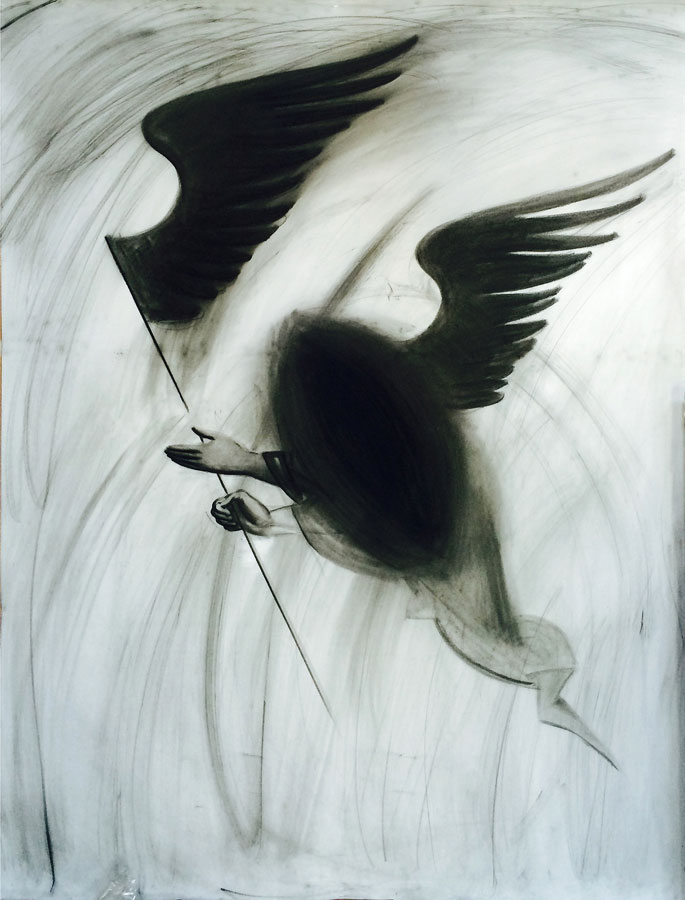
He Cut His Wing and Made a Flag off It, 2017, charcoal on paper, 195 x 150 cm
'High Disease', the title of Nikita Kadan's third exhibition at gallery Transit, is derived from a poem by Boris Pasternak. The poem, which Pasternak himself called 'the fragment', refers to a revolutionary epic.
This year, exactly 100 years after the October Revolution, we face the dominance of shattered, torn and fragmented images . The images of Vasili Jermilov, Georgi Narbut and Aleksandr Rodtsjenko used in the exhibition illustrate the different stages of the revolutionary condition: from the joyous view on the crumbling old world to the fear that permeates the confined and oppressive atmosphere of the emerging counterrevolution. Yet, like the archival images taken during the decommunization – often of Soviet monuments being destroyed – these images, similarly, are nothing but debris. In a similar way, the collective memory of the revolution in Ukraine is but a ruin. This exhibition is an effort of reconstruction, from the old ruins.
The impossibility of an epic becomes a prerequisite for a contemporary manner of expression, and of its basic context. The statement as such becomes neurotic and is entirely soiled by the frustration of its impossibility. Still, this frustration encourages us to create, through the collection of fragments, a pseudo epic. In reality, however, it is but a reference to the possibility of an epic. In High Disease, the main character, the "fool, hero, intellectual", has an encounter with history. Today, this encounter seems to evade us; it is, however, not entirely impossible to experience it. We can do this when we connect, in a correct manner, all the pieces of ruins of the revolution that surround us.
Nikita Kadan presents a new series of large-scale charcoal drawings, and one new sculpture.
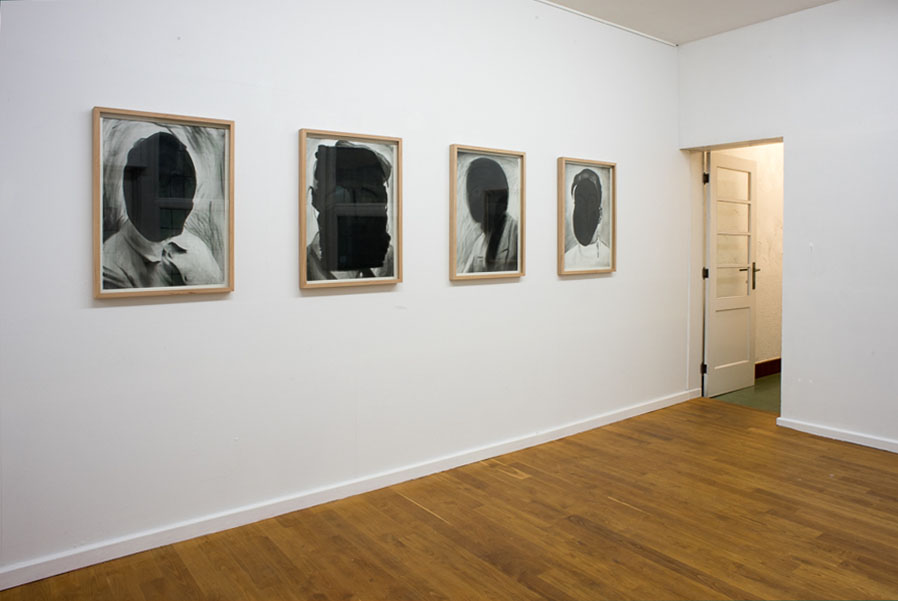
The Spectators (Rodchenko Portraits), 70x50cm, courtesy M HKA collection
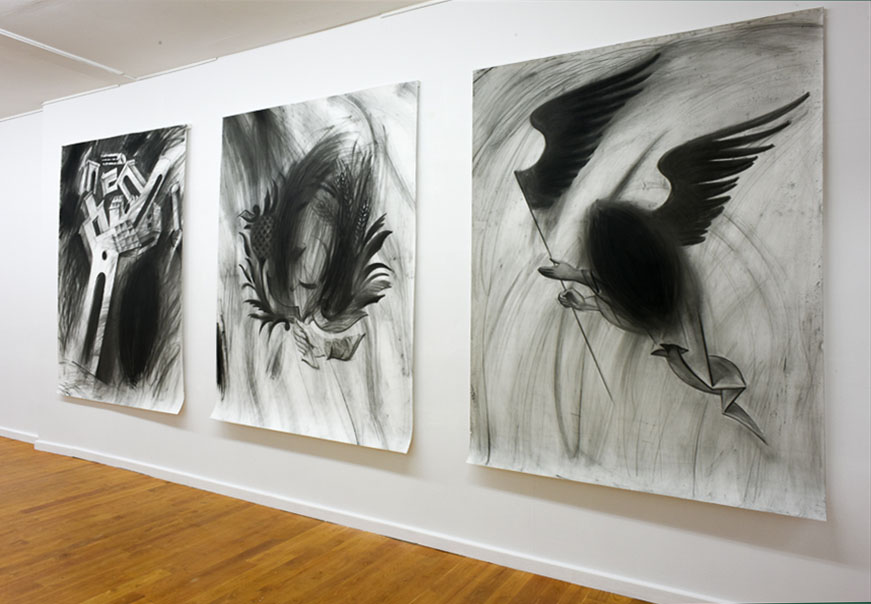
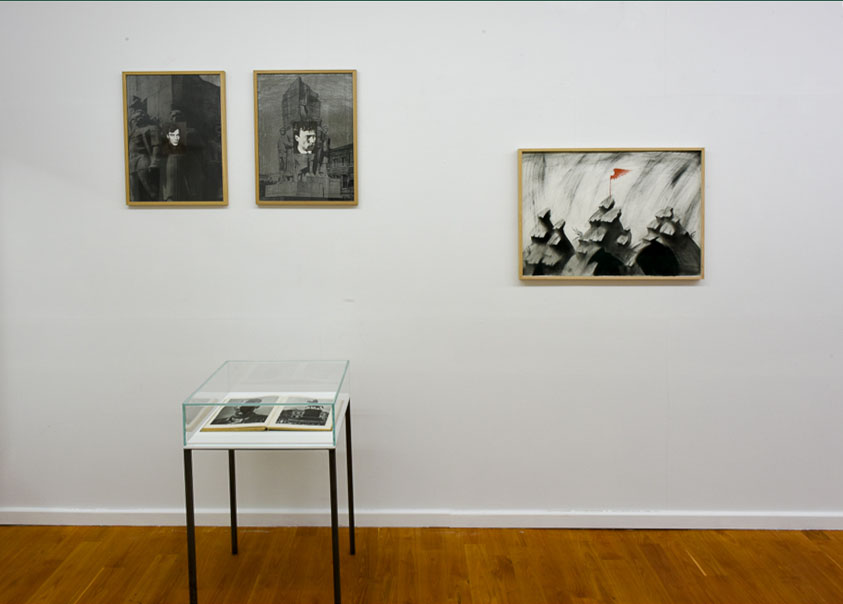
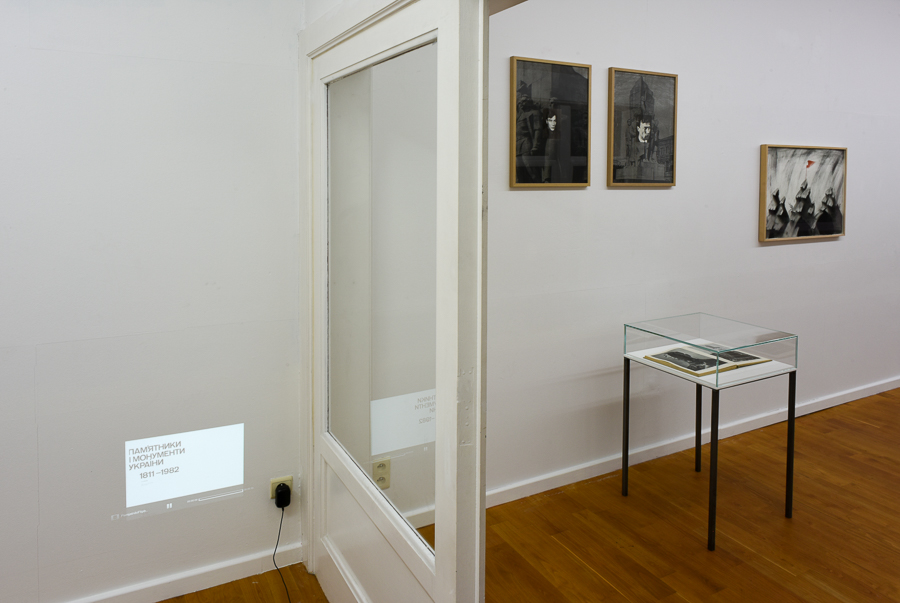
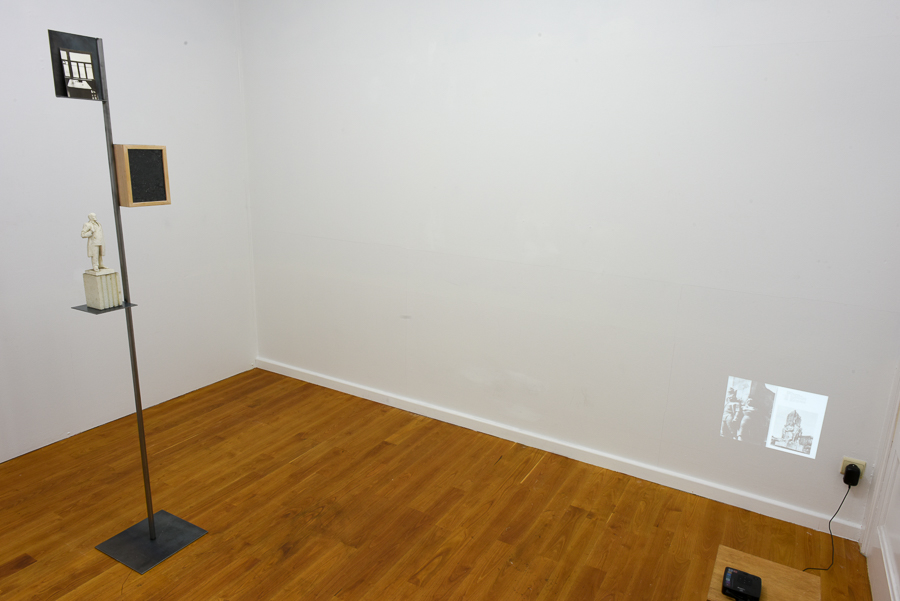
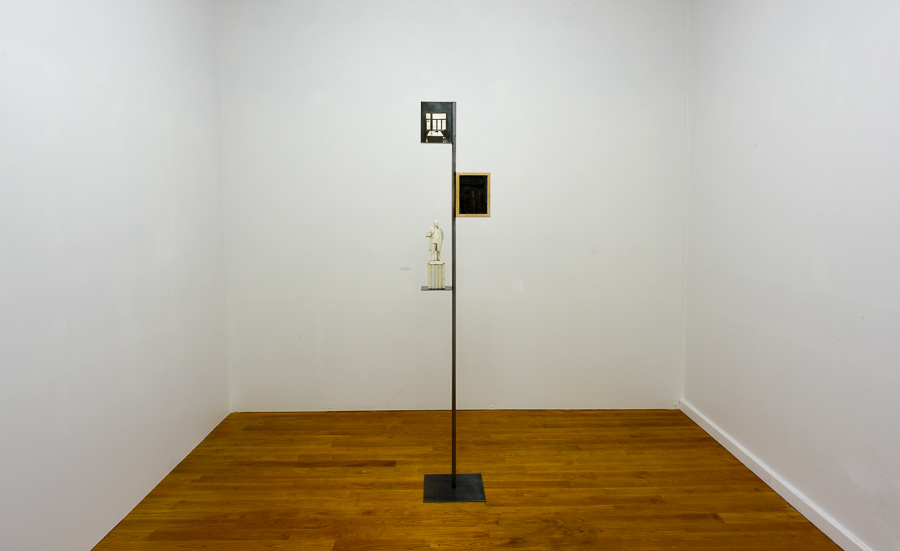
Dark Air, Scientist, Serpents & Devils, 2016
Rather than dissecting the ideology of postcommunism by apologetically showcasing the breakthroughs of the Soviet era, Kadan takes the political stance by reflecting both through an agonistic logic. Here the moments of premodern, modern and postmodern are not to be ascribed to different historical periods, but are moments that permeat both communism and post-communism. And while neoliberalist agenda strives to deprive politics of all its dialectical stamina, preaching the futility of unneccessary ideological divisions, depoliticizing the politics of today and neutralizing past struggles, Kadan's work insists on its complexities. Thus as dark clouds rise to blurr the sight of the heroic vision of the past in the series of drawings Dark air that set the tone for the whole show (1), we are forced to examine both the great emancipation narrative of communism and its manipulation the disillusioned politics of today, with Kadan insisting that the battle for their signification is far from over.
(1) reference to exhibition in Arsenal Galeria, Bialystok, sept. 2016.
Photographs comprising Dark Air show military monuments from the Soviet era: the official canon of memory, in glaring contrast to memory archived, and to personal memory as a backdrop for the monument. The monument may be perceived in reverse to "unrecognised" memory, a thing continued and extended over time. Its illusionary "dark clots" become a separate component of the image, distorting perception.
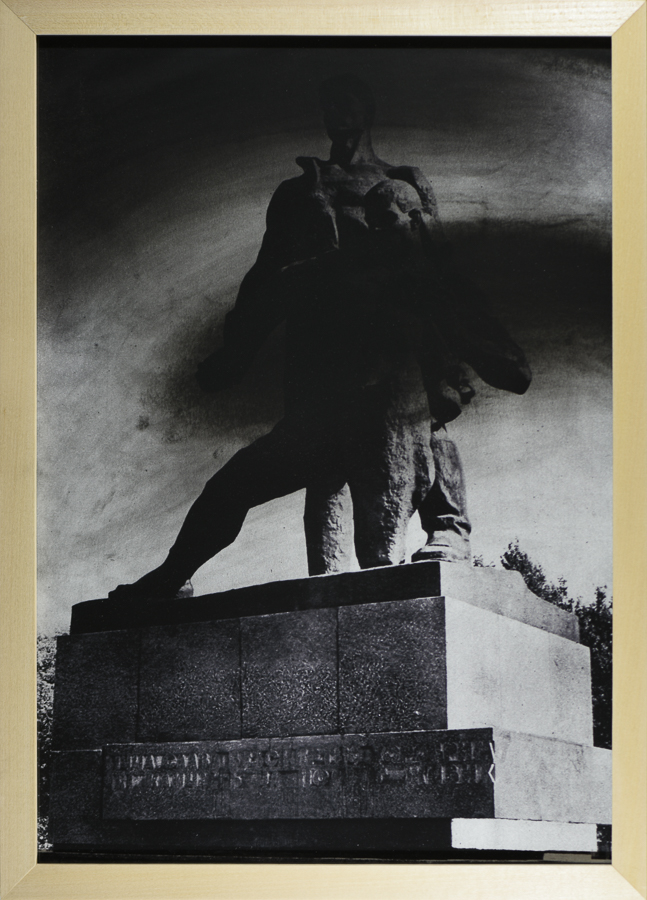
Dark Air 3, charcoal on photo, 60 x 42 cm, framed, 2016
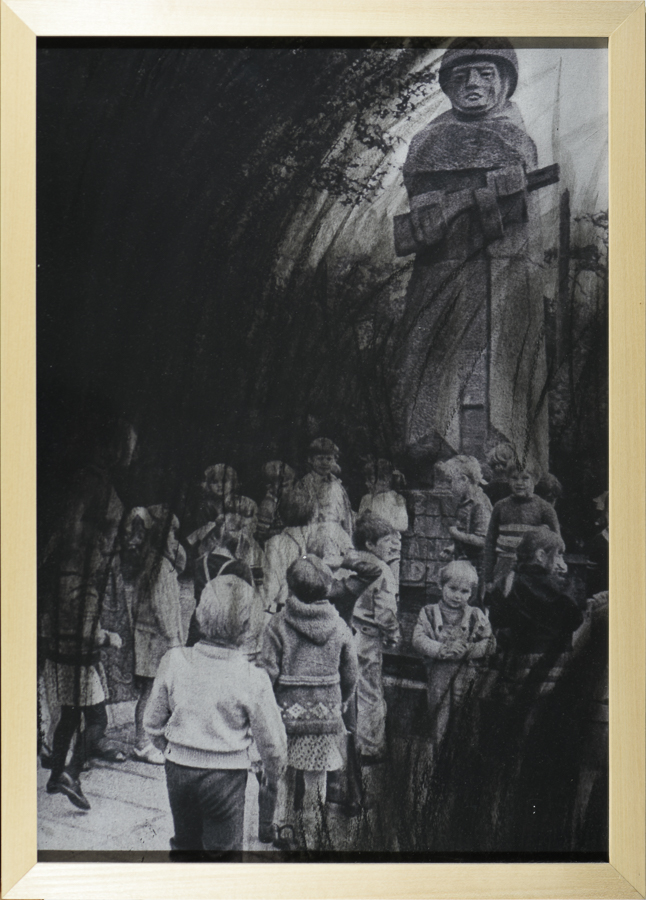
Dark Air 2, charcoal on photo, 60 x 42 cm, framed, 2016
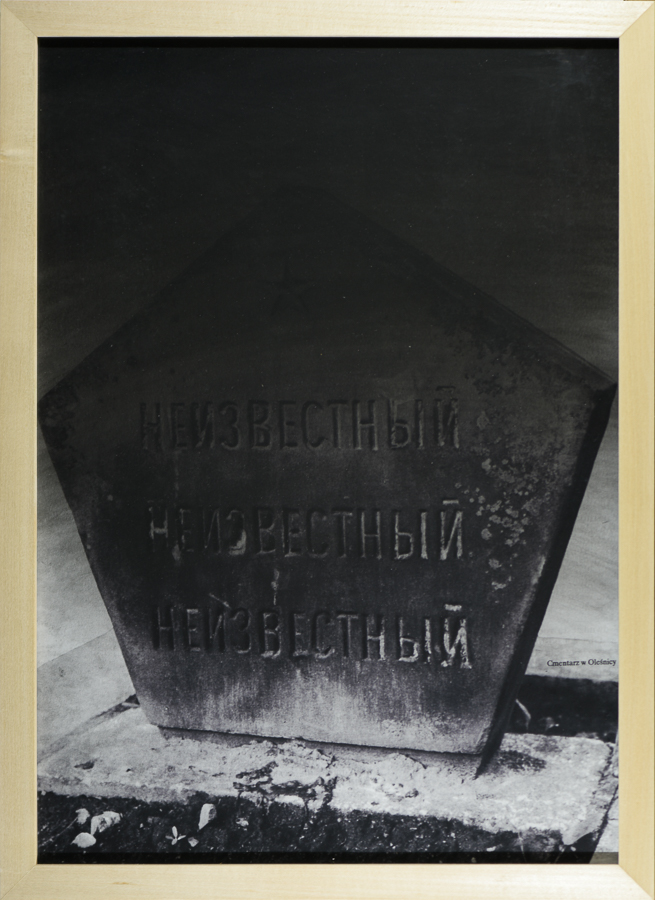
Dark Air 4, charcoal on photo, 60 x 42 cm, framed, 2016
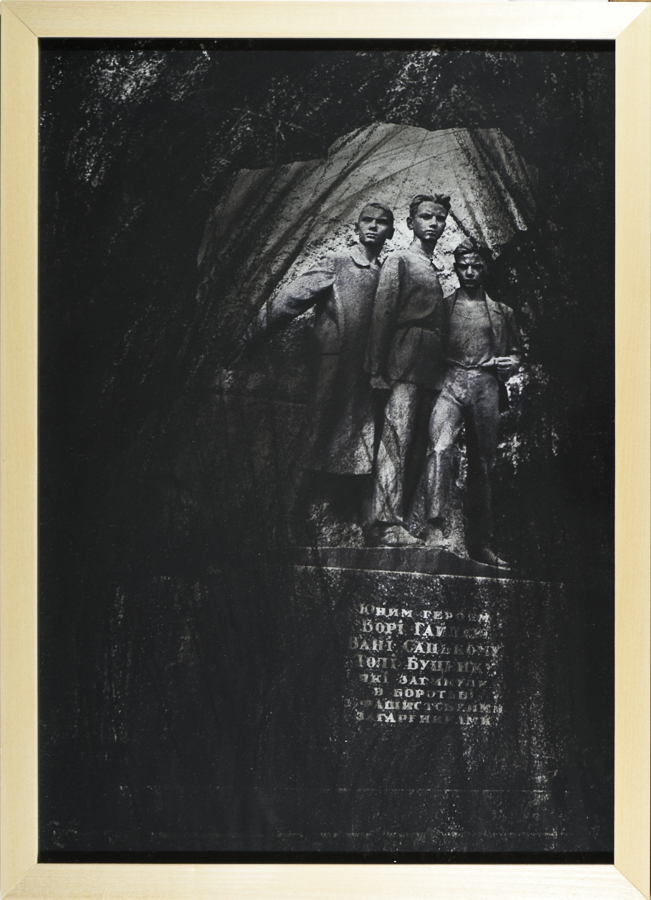
Dark Air 1, charcoal on photo, 60 x 42 cm, framed, 2016
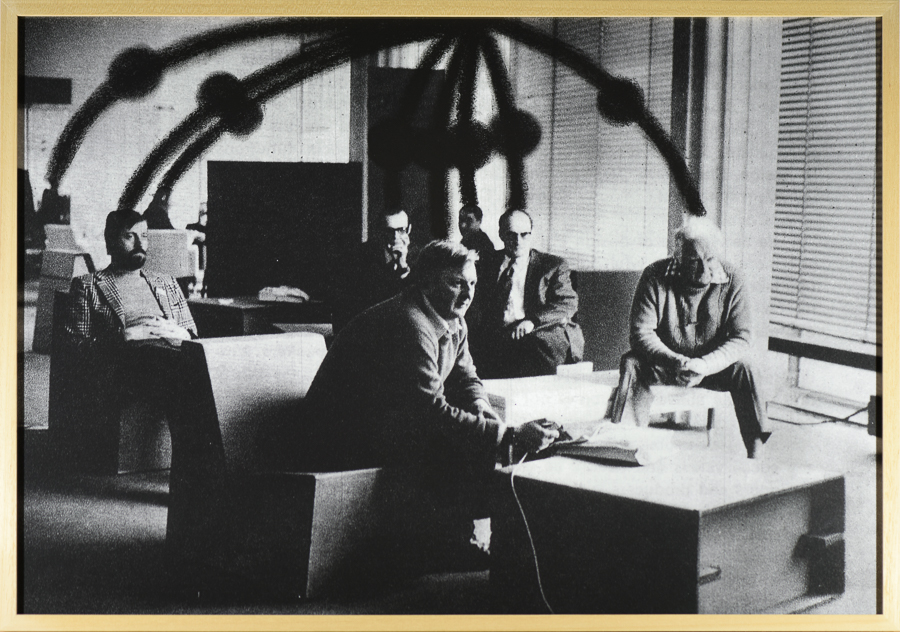
Dark Air 5, charcoal on photo, 50 x 71 cm, framed, 2016
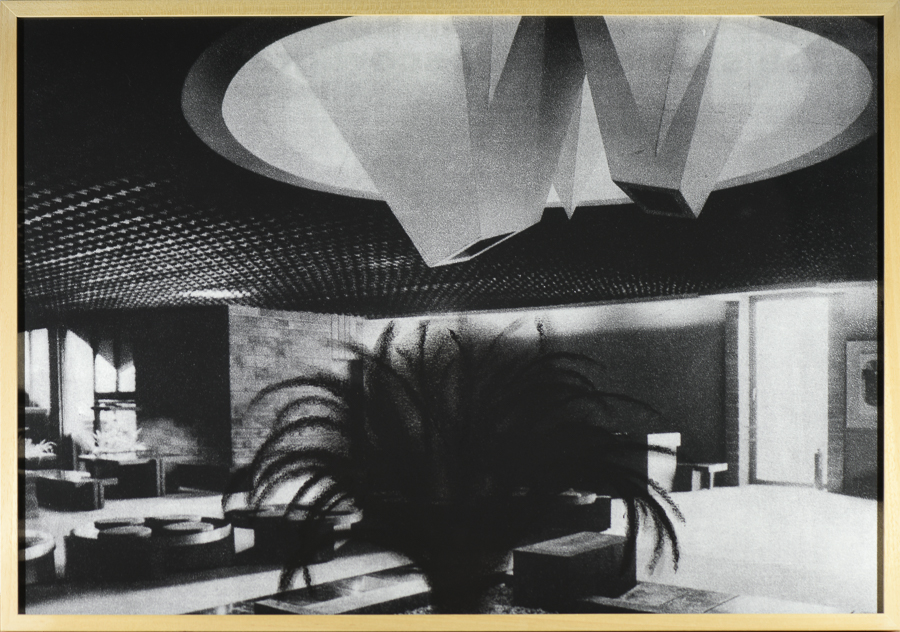
Dark Air 6, charcoal on photo, 50 x 71 cm, framed, 2016
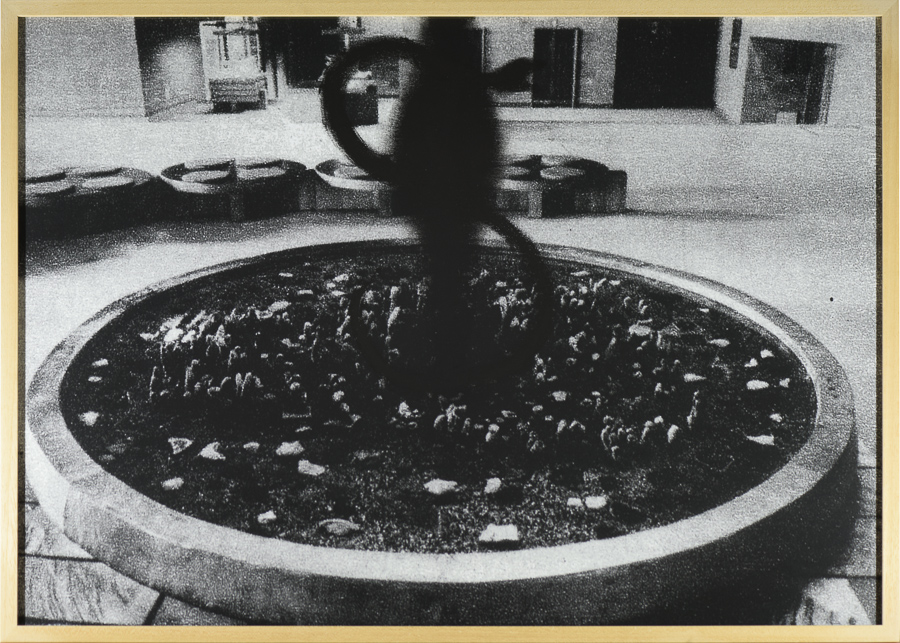
Dark Air 7, charcoal on photo, 50 x 71 cm, framed, 2016
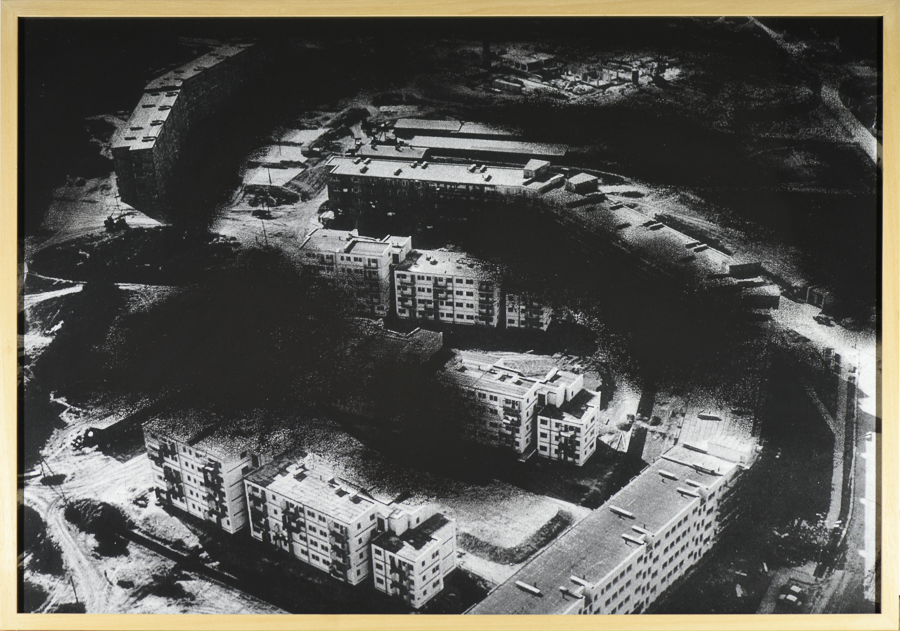
Dark Air 8, charcoal on photo, 50 x 71 cm, framed, 2016
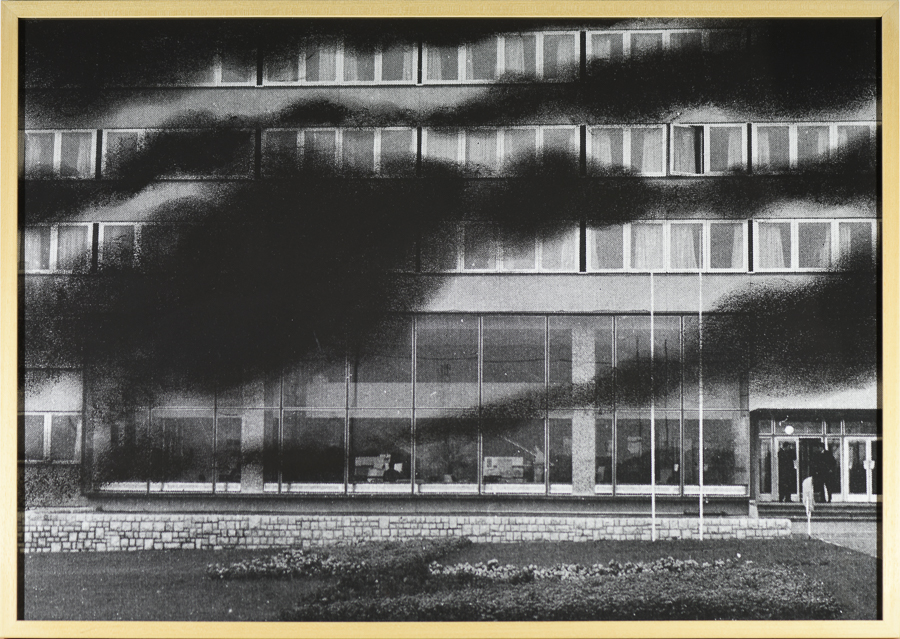
Dark Air 9, charcoal on photo, 50 x 71 cm, framed, 2016
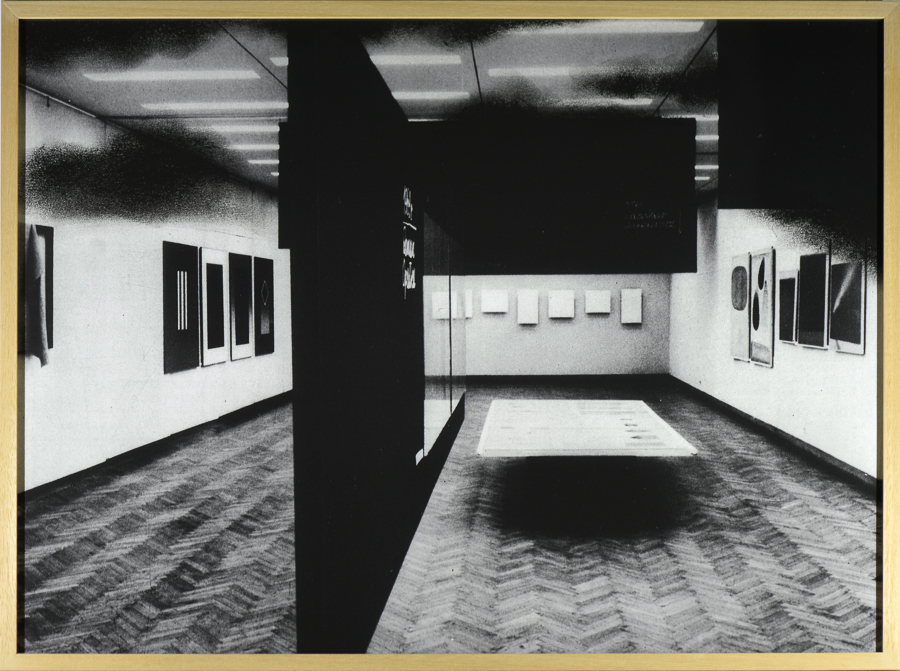
Dark Air 10, charcoal on photo, 50 x 71 cm, framed, 2016
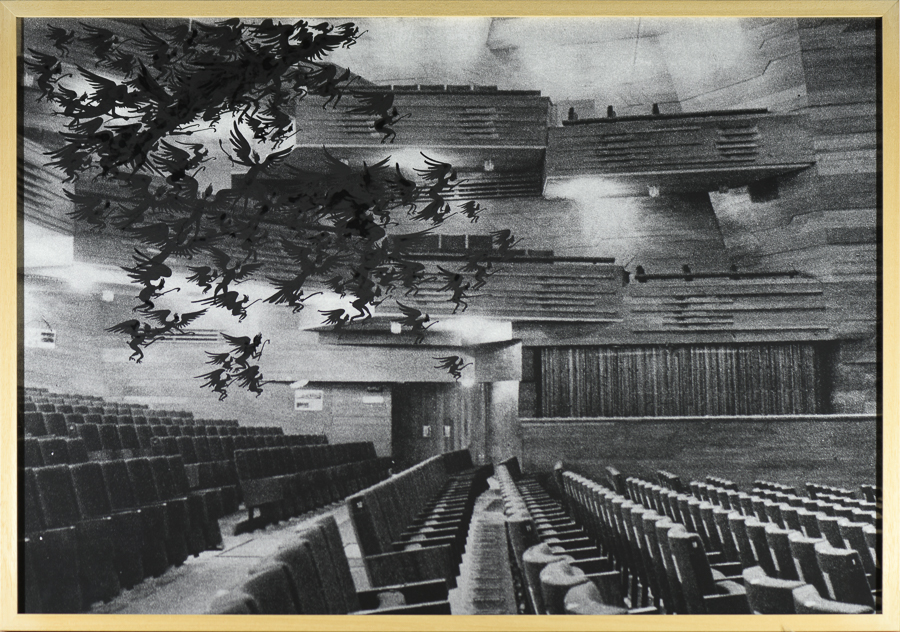
Devils, charcoal on photo, 50 x 71 cm, framed, 2016
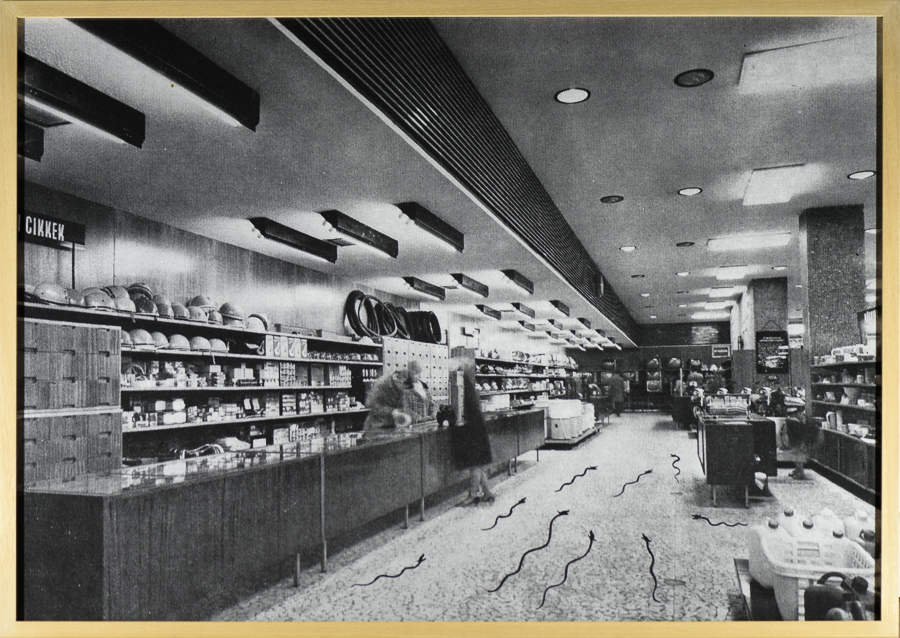
Serpents, charcoal on photo, 50 x 71 cm, framed, 2016
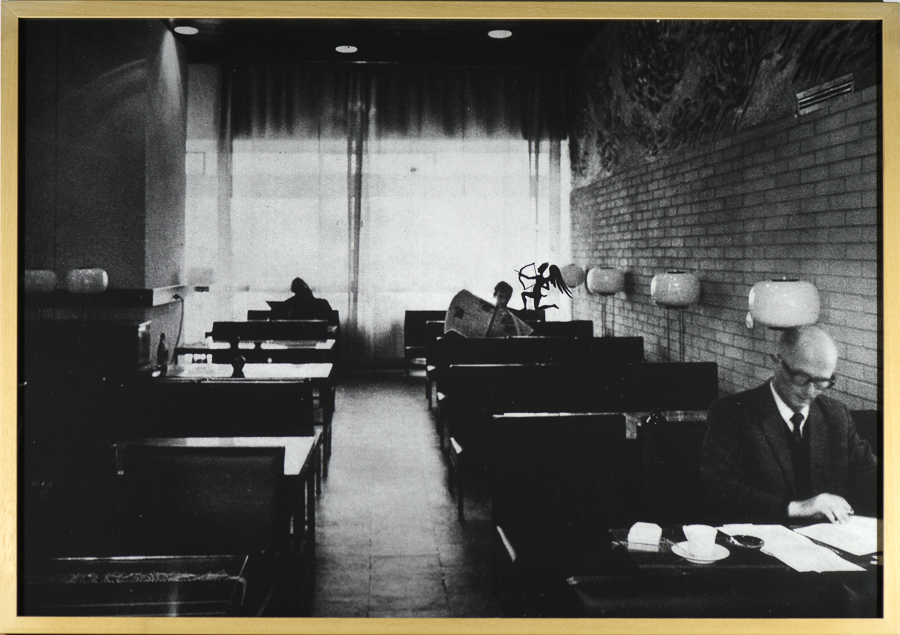
Devils with a Bow, charcoal on photo, 50 x 71 cm, framed, 2016
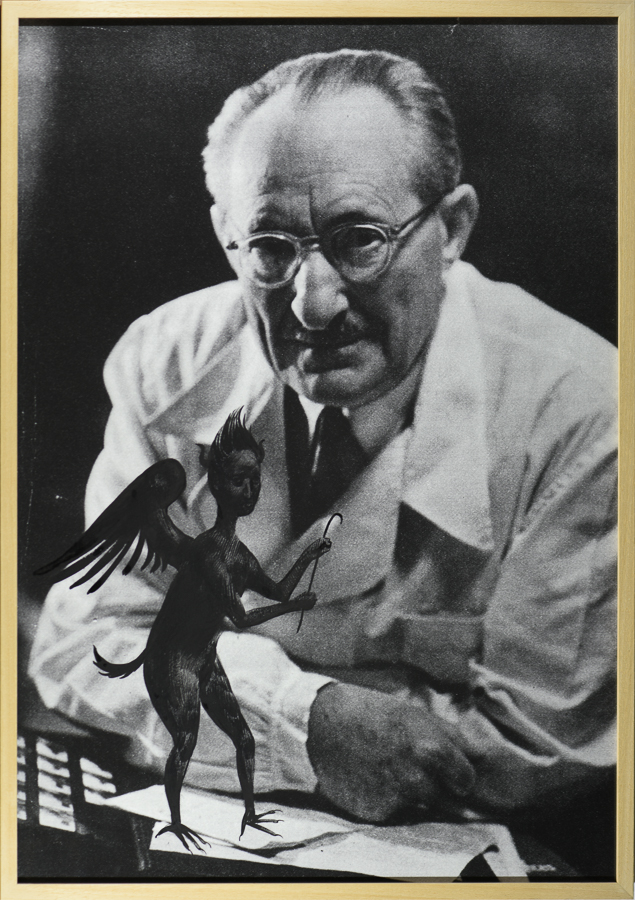
The Scientist and the Devil, charcoal on photo, 71 x 50 cm, framed, 2016
Riza, 2016
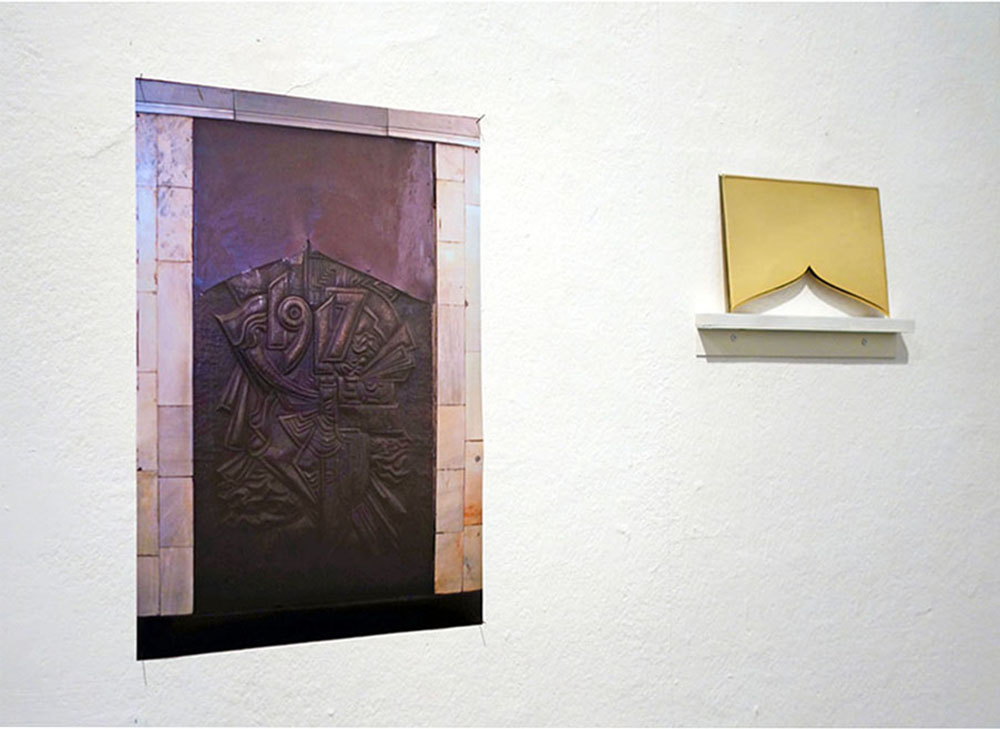
Riza is the replica of a metal element improvised by workers of Kyiv Metro to hide the communist symbolics on a bronze basrelief, devoted to the October revolution of 1917. They act according to the current Ukrainian 'decommunisation laws'.
[Wikipedia about Riza:] Riza ( Revetment or Oklad which means "cover", "coating"), sometimes called a "revetment" in English, is a decorative metal cover protecting an icon. The purpose of a riza is to honour and venerate an icon, and ultimately the figure depicted on it. The riza helps protect the icon. A riza is designed specifically for the icon it is to cover. It leaves open spaces where the face, hands, and feet of the icon's subject can be seen.
Everybody Wants to Live by the Sea | Art Brussels 2016
all: 2015, Gouache & inkjet print on Museum Etching Paper, 47,3 x 64 cm
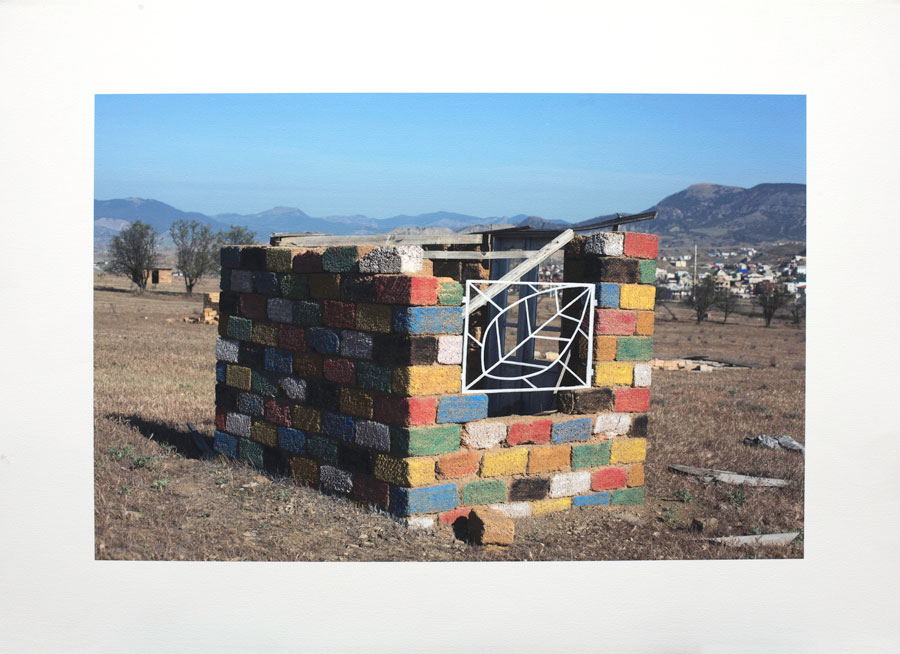 A
A
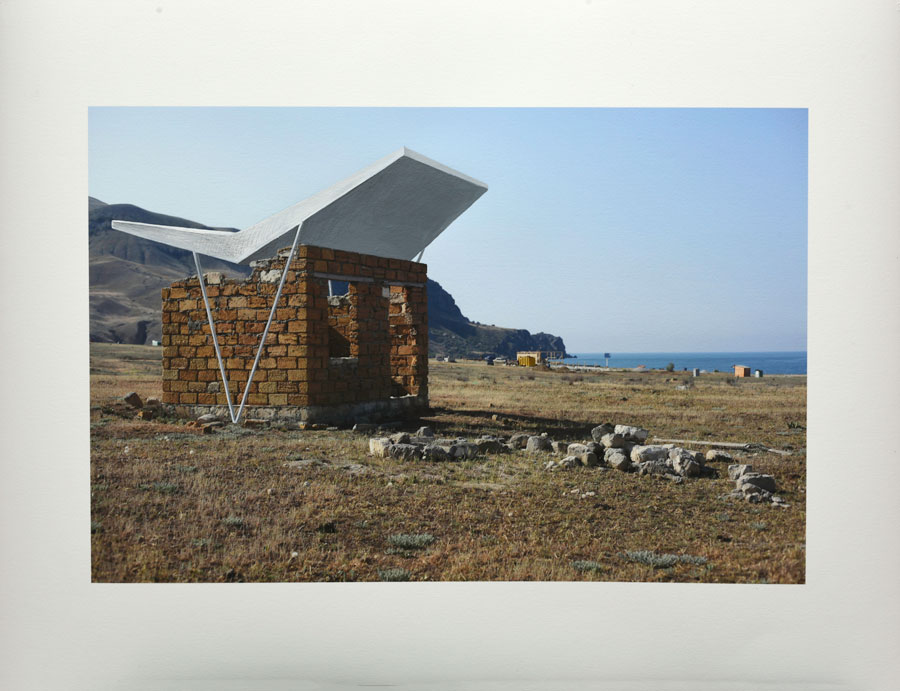 B
B
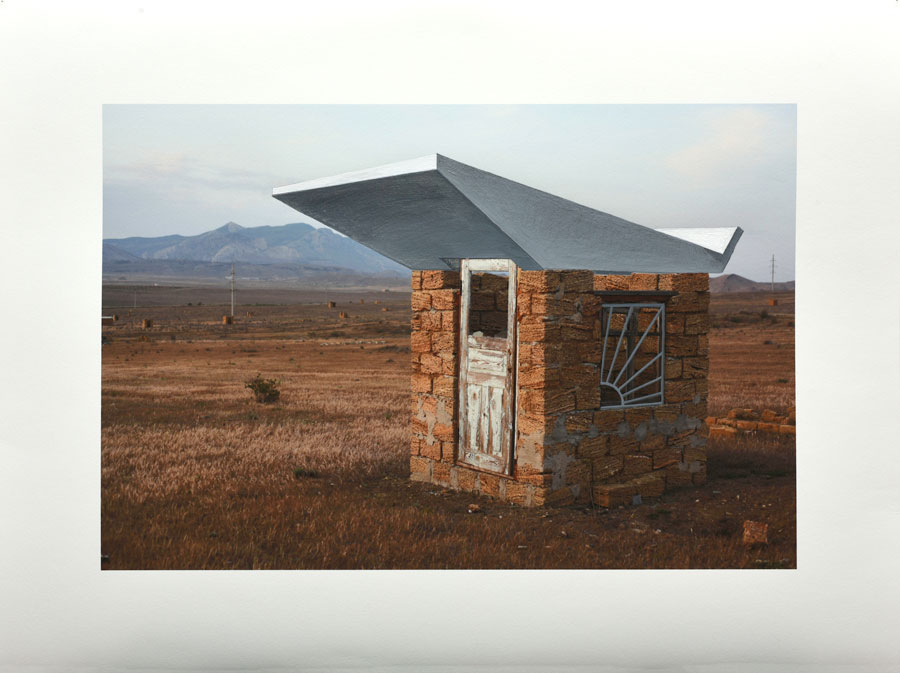 C
C
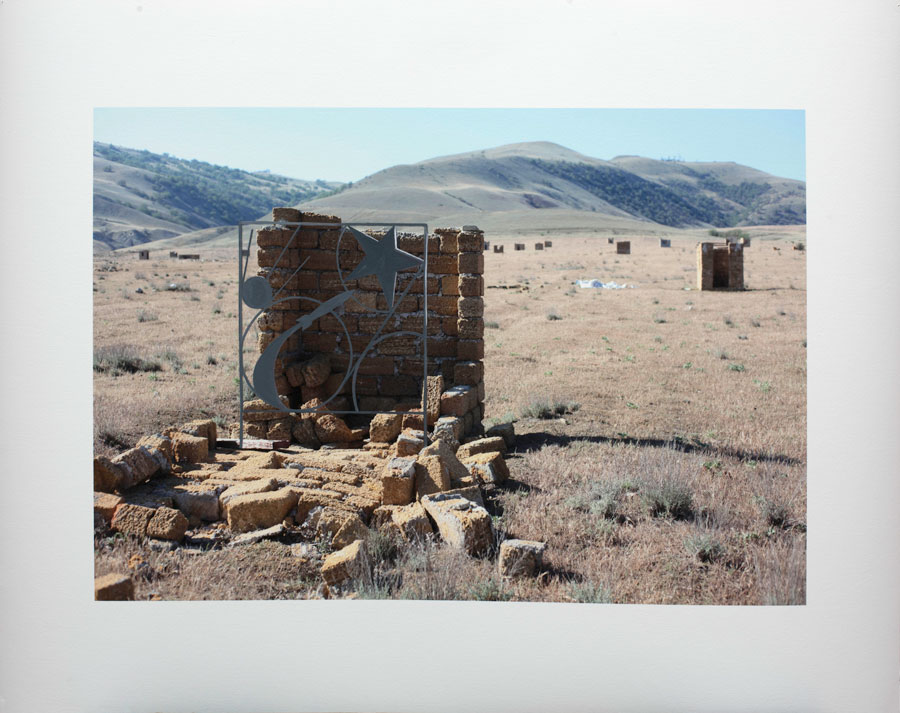 D
D
Nikita Kadan, Gazelka | Art and the Struggle of Ideologies | 30.08 - 04.10.15
Open: vrijdag, zaterdag & zondag 14 - 18 uur, of na afspraak.
Parking [Zandpoortvest 2] tegenover de galerie, gratis in het weekend, op andere dagen € 0,30/uur
hART [nr 145] schrijft over deze tentoonstelling:
Galerie Transit in Mechelen ontdekte Nikita Kadan, de jonge en reeds veelgevraagde Oekraïense kunstenaar, heel vroeg. Zijn nieuwe solo 'Gazelka & Art and the Struggle of Ideologies' oogt droog documentair, maar niet voor lang. Het is een scherpzinnige display met een vlag van door granaatscherven opengereten autocarrosserie, een stukje van de oorlog in Oekraïne. Alsook de verbazende en bijna hilarische sovjetkijk op westerse kunst.
"Ik wil een westerse avant-gardekunstenaar zijn, zoals die kunstenaars werden beschreven door de sovjets: dat zei ik toen ik in de jaren negentig sovjetboeken over kunst las. Ze hebben me aangezet om naar de kunstschool te gaan." Nikita Kadan (°1982, Kiev) stapt dan naar twee Russische pockets. "Kijk, dit is 'Crisis van Lelijkheid. Van kubisme tot pop art'. Hier heb je Hartung en Miró bij een schilderij van een schizofreen. De slechte kwaliteit van die reproducties, daar hou ik ook van. De commentaren kunnen vrij positief zijn. Over 'Elegy to the Spanish Republic' van Motherwell zeggen ze dat het mysterieuze abstracte symbolen zijn, hij zit verkeerd, maar hij is ook in staat om westerlingen te mobiliseren voor de politieke strijd." Uitvergrote pagina's tonen commentaren op Motherwell, Kienholz, Matta en meer kunstenaars, allemaal vertaald voor de bezoeker. De platen komen uit een sovjetpocket van 1978, een boek uit de reeks 'Art and the Struggle of Ideologies'. Helemaal readymade is de ingelijste sovjetbrochure 'Tegen abstracte kunst' met commentaar op Rothko. Zo onthult Nikita Kadan wat hem dreef om kunstenaar te worden. Zijn haarsnit doet denken aan James Dean. Maar hij is geen 'rebel without a cause'. Kritisch museum De blikvanger, als je het zo kan noemen, is de vlaggenstok. De grauwe vlag met inslaggaten is gemaakt van de cabine van een bestelwagen van het Russische merk GAZ, die 'Gazelka' wordt genoemd. Materiaal uit de oorlogszone, zoals hij het vond. In een reeks tekeningen verdwijnen zowel communistische monumenten die uit protest worden gesloopt als Oekraïense monumenten die door pro-Russische rebellen worden vernietigd onder de sneeuw: een vel kalkpapier waarop contourlijnen zijn getekend, alsof nieuwe landen worden gevormd. 'Observations on Archives' is een reeks lijsten met zwart-witbeelden die deels zijn bedolven onder steenkool. Een persoonlijk archief met oude foto's van gebouwen in de huidige oorlogszone en verdwenen kunst van Robert Smithson, Wolf Vostell, Jan Dibbets. "Archieven kunnen niet overleven in Oekraïne. Net zoals in andere oorlogen gaan ze in vlammen op. Het oosten van Oekraïne, het oorlogsgebied, is de mijnstreek. Er wordt gezegd dat de mijnwerkers pro-Russisch zijn, maar dat heb ik niet gemerkt toen ik met hen sprak. Ze zijn wel bang dat de mijnen zullen sluiten." Nog voor de protesten in 2013 uitbraken in zijn thuisstad Kiev boog hij zich over het historisch museum. "Hoe kan ik de complexiteit van de situatie tonen? Ik begon het te bekijken alsof het reeds een historisch museum is. Het is geen strikt wetenschappelijke analyse, maar een individuele en ook intuïtieve keuze." Meer werk staat in de biënnales van Kiev, Venetië en Istanbul (daar de grote installatie 'The Shelter'). Op zijn minst een boeiende kunstpraktijk. Dat zie je in het eerste overzichtsboek, een uitgave van Transit. Wellicht het meest bekend is 'Procedure Room' (2009-2010), porseleinen borden bedrukt met tekeningen van foltertechnieken. Sociaal-politiek activisme? "Ik geloof niet erg in activistische kunst. De borden zijn al gebruikt in een campagne tegen geweld. Zo kunnen kunst en activisme tijdelijk samenkomen, net zoals kunst en het historisch museum." Maar wat hebben wij, westerlingen, aan een display over Oekraïne? "Het is nodig om te begrijpen wat er gebeurt", repliceert hij. "Er kan een nieuwe koude oorlog op til zijn. Het gaat ook over het leven in het Westen, niet rechtstreeks, maar het is ermee verbonden."
Christine VUEGEN
Foto's van de tentoonstelling, klik hier
Difficulties of Profanation
Ukrainian Pavillion @ Venice Biennial 2015
A traditional showcase, in its form and material referring to showcases from the Soviet Union, accumulates materials that Nikita Kadan has collected in eastern Ukraine during the war. The rubble inside reveals political narratives with a striking truthfulness: these destroyed artefacts are containers of words, of images and memories that narrate a (present) history. Thus the sculpture deals with the institutionalization of memories, the role of local heritage in forming a historical understanding against the cultural amnesia resulting from the conflicts. The showcase itself, in opposition to the rubble it collects, addresses Ukraine’s Soviet past, a part of history that is rather readily forgotten. It places the current conflict in a historical framework and presents the war as an extension of an established conflict of ideologies.
In between the rubble, inside the showcase, grows a bean plant that over time will cover the destroyed artefacts. It transforms the sculpture into a greenhouse, referring to popular gardens that appeared throughout the conflict, starting on the occupation of Maidan Square and continuing to the warzone in Dombass. These gardens suggest hope, a new start, a future life and process of reconciliation.
Everybody Wants to Live by the Sea | Fabrica del Vapore Milano & Transit Gallery | 2014
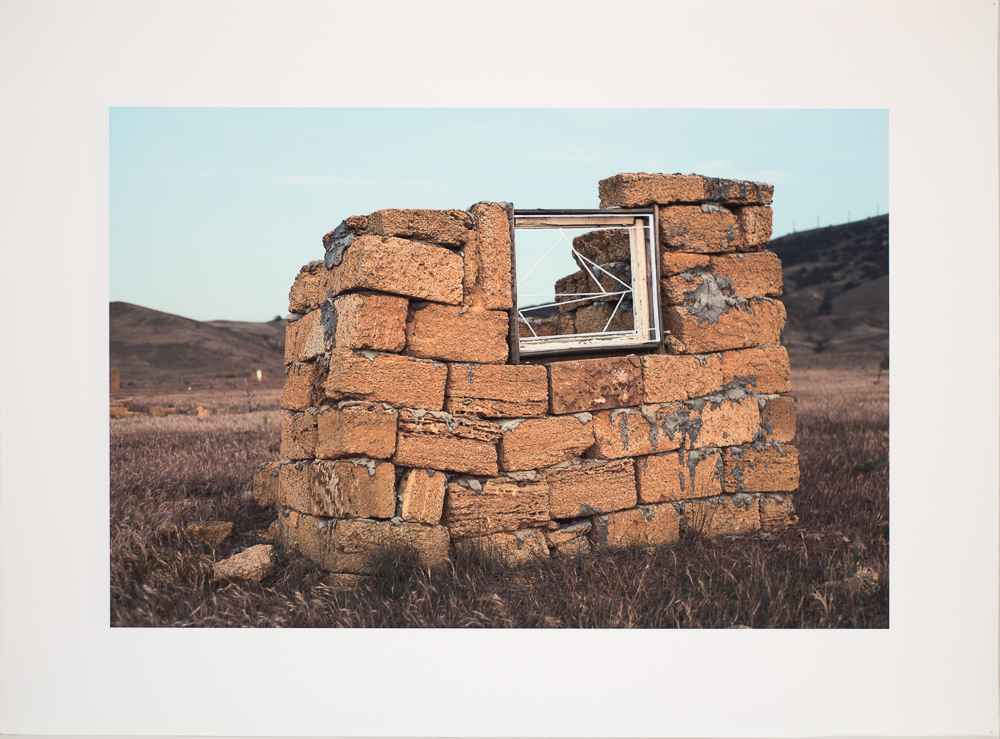 1
1
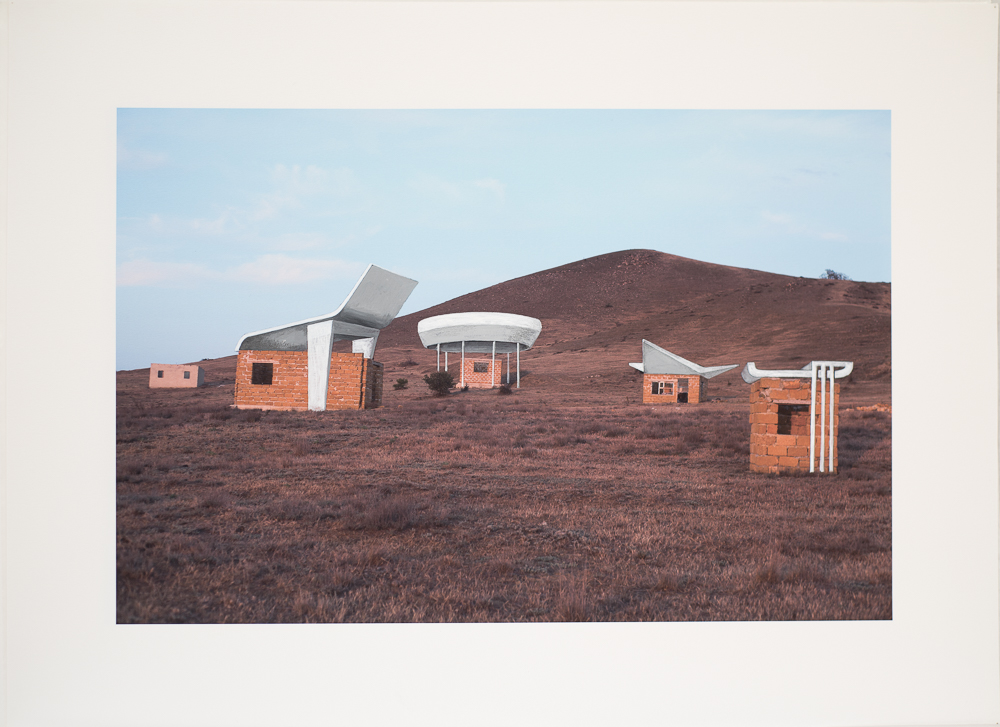 2
2
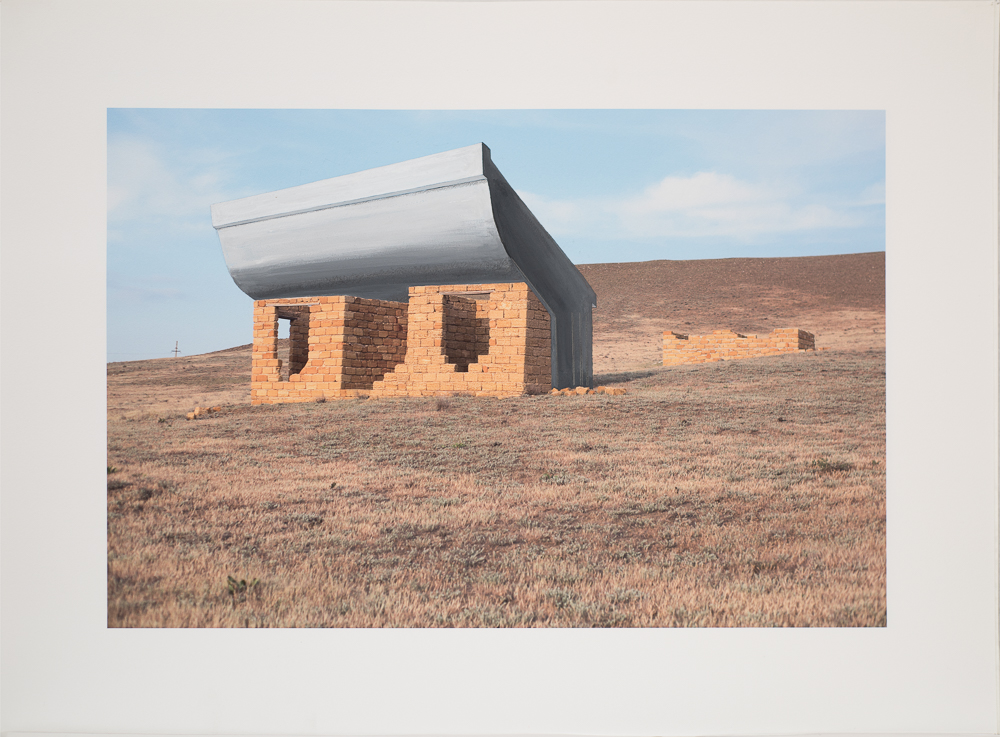 3
3
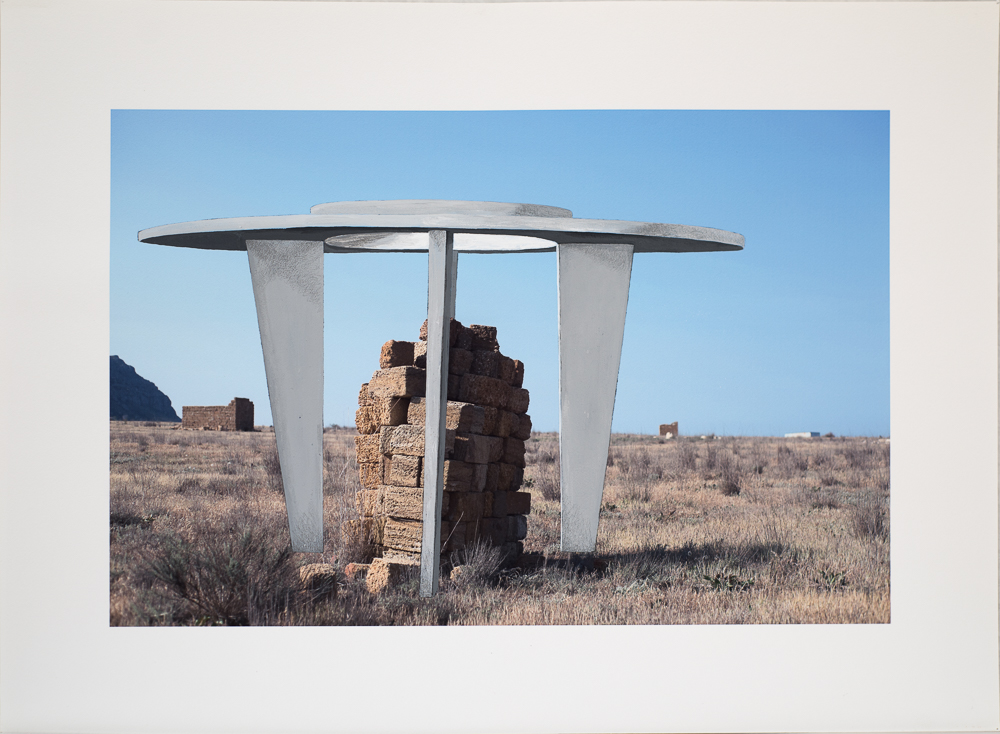 4
4
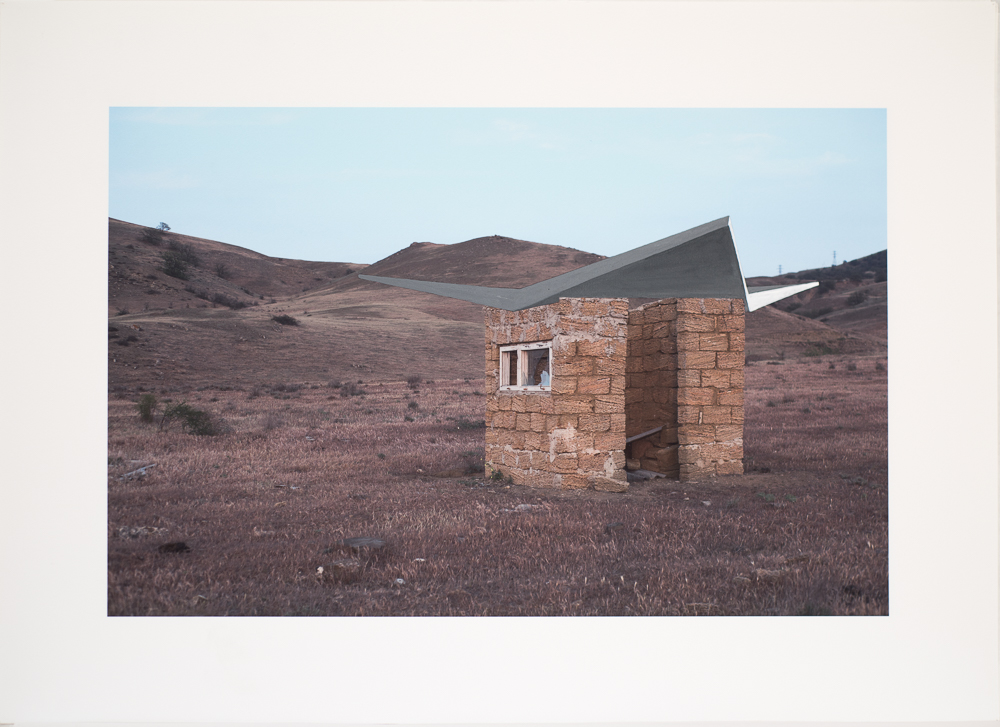 5, private collection
5, private collection
[...] A significant example of the use of storytelling to connect facts and events that the dominant system tends to hide is the work Everybody Wants to Live by the Sea(2014). Nikita Kadan goes deep into the past of Crimea when this land was the subject of dispute between the Tartars living there and the Soviet state wishing to build there a resort infrastructure. Hidden memories of the peoples, nations and states struggling for the possession of the peninsula as well as the artist's personal memories are transformed in a semi-documentary display of imagery and distinctive architectural forms that tells the story of the land, its past and, consequently, its future. Tartars vernacular architecture represents something which was not absorbed by the soviet project and which return is evident in the post-soviet reality. These pieces of striking reality, ruins of a disintegrated everyday-life, made difficult by a new order of things, are in a sharp contrast with the abstract figure of the soviet past, identified with the facades of the neo-modernist soviet architecture. The tatars are nowadays a shameful and degraded image on the background of society. The ready-made parts of the work represent here an intersection of reality with a strong sense of degrading materiality which intentionally tries to cynically disturb the viewer revealing invisible parts of our present. [...]
[Fragment of a new text by Sylvia Francescini, 2014, to appear in forthcoming book about Nikita Kadan]
All works: gouache & inktjetprint on Museum Etching Paper, 47,3 x 64 cm
Barricade Watercolors | Solo Art Brussels booth Transit Gallery | april 2014
Barricade, 48,5 x 68,5 cm, 2014, watercolor on paper
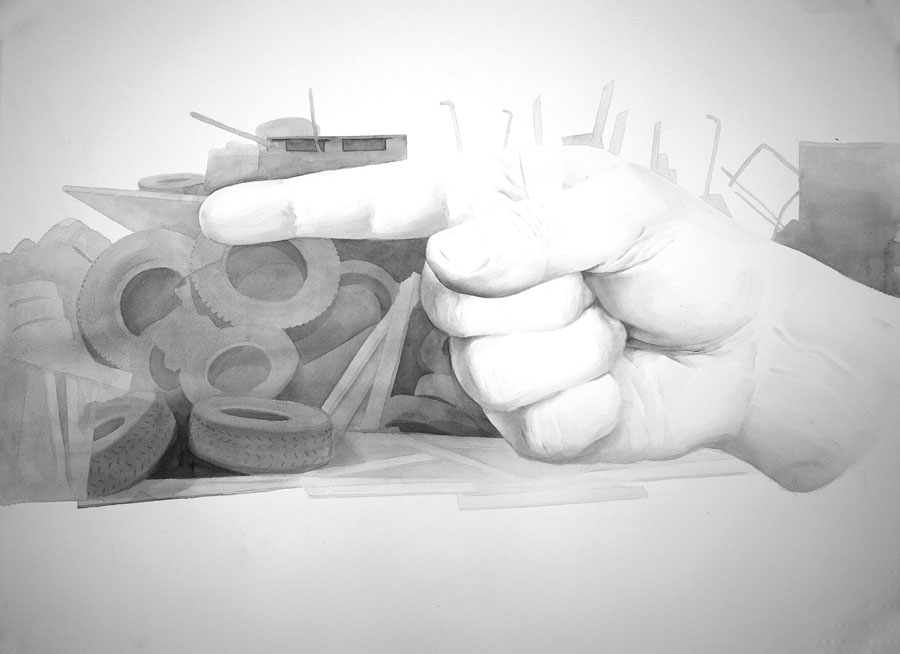
Barricade, 48,5 x 68,5 cm, 2014, watercolor on paper, private collection
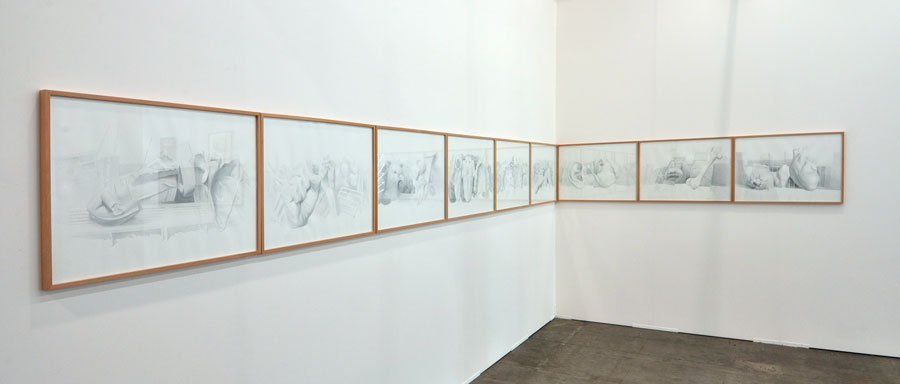
Exhibition view Engineering Hope in Art Brussels 2014, boot Transit Gallery
Sungrid
"The incandescent rays of light in Private Suns by Nikita Kadan reflects an aura of freedom – which is increasingly being reduced in public space – from a private space. The visitors remain outside the utopian horizons created by the shining image of the neon suns of a post-socialist metal grid, where others (artists?) have sought to find a new dimension. The grid is only effective as a formal and ideological tool when it is not perceived as an escapist structure."

fragment from slideshow, 2014
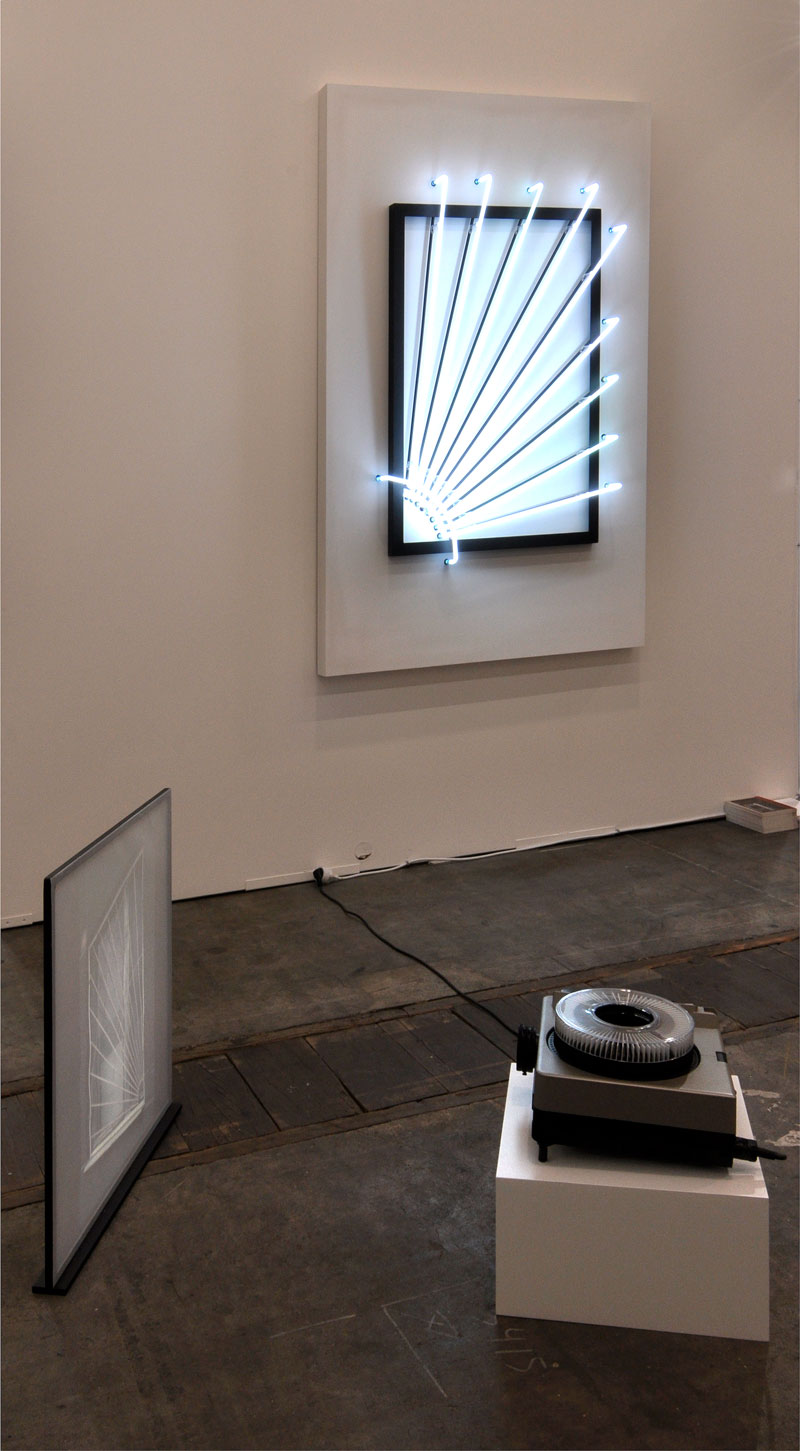
Neon Sun Grid, as exhibited in Nikita Kadan's solo show Engineering Hope in Art Brussels 2014, booth Transit gallery
Nikita Kadan | wegvegen en overplakken | erasing and overposting
galerie Transit Mechelen | 07.04 - 19.05.2013
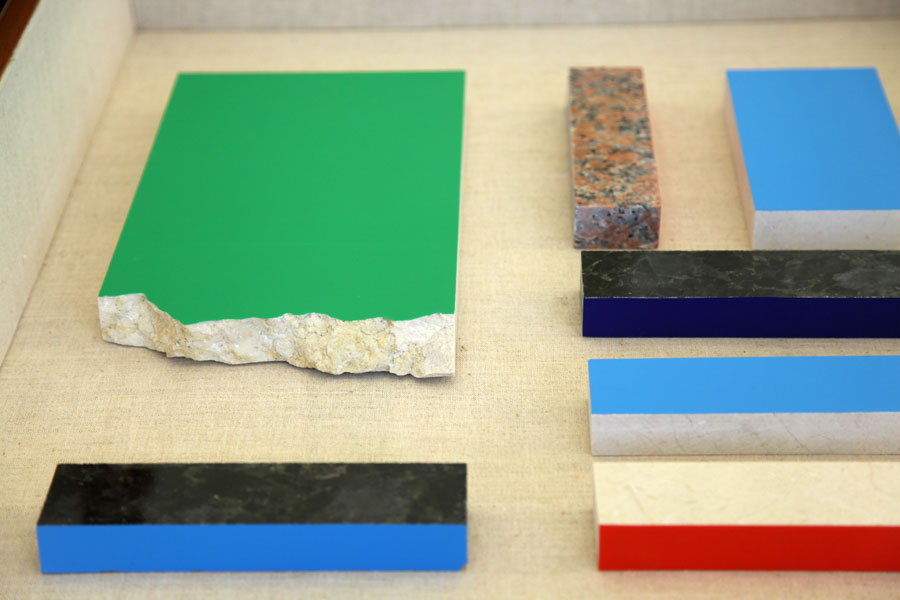
Nikita Kadan werd geboren in 1982 in Kiev, Oekraïne, een land dat tot 1991 in de ban was het Sovjetregime en in 2004 nog geconfronteerd werd met de Oranjerevolutie omwille van het vermoeden van een vervalste verkiezingsuitslag. Deze turbulente maatschappelijke context van Kiev en Oekraïne bepaalt tot op heden de artistieke praktijk van Nikita Kadan als kunstenaar, schrijver en activist.
|
Nikita Kadan was born in 1982 in Kiev, in the Ukraine, a country that was controlled by the Soviet Regime until 1991. More recently, in 2004, the country was confronted with the Orange Revolution due to superstitious election results. This turbulent social context of Kiev and the Ukraine, determined up to the present the artistic practice of Nikita Kadan as an artist, a writer, and an activist.
Nikita Kadan is the winner of the Pinchuk Art Centre Prize 2011. This summer, his work ‘Small House of Giants’ will be exposed at the ‘Future Generation Prize’ exhibition, during the Venice Biennale. In Belgium, he showed work at ‘Newtopia’ (Mechelen) and in the spring of 2013 he will be an artist in residence in Flacc Genk. |
Catalogue of Opportunities
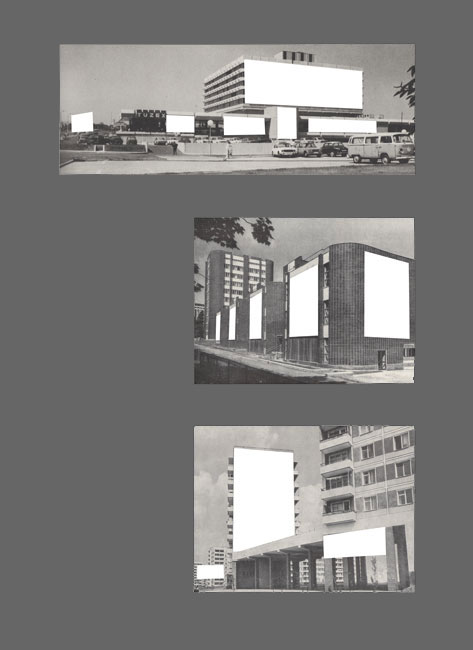
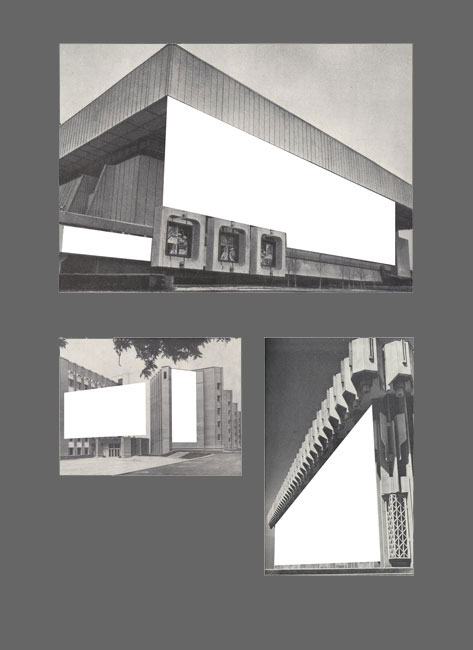
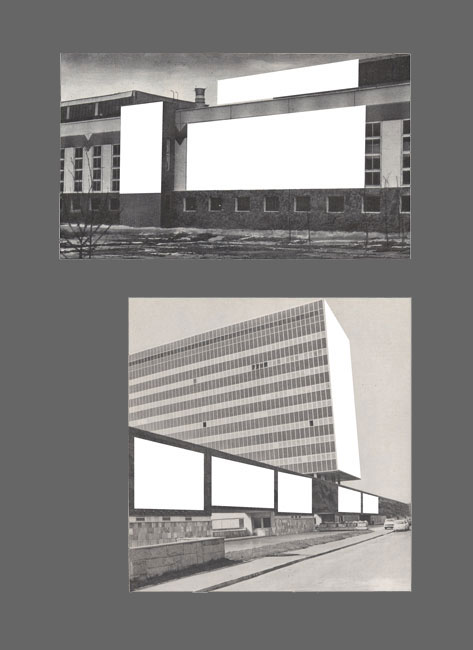
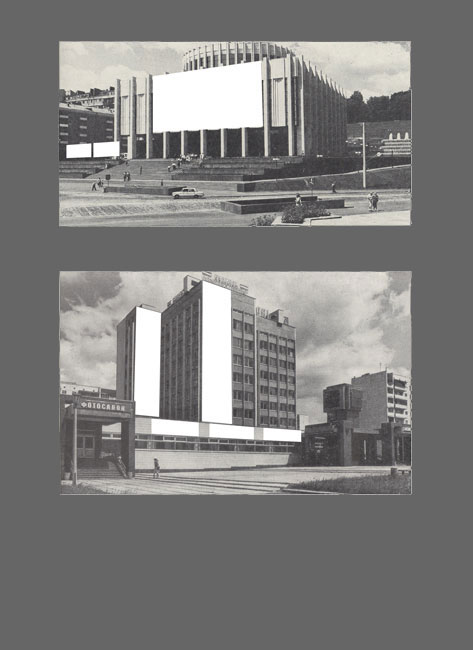
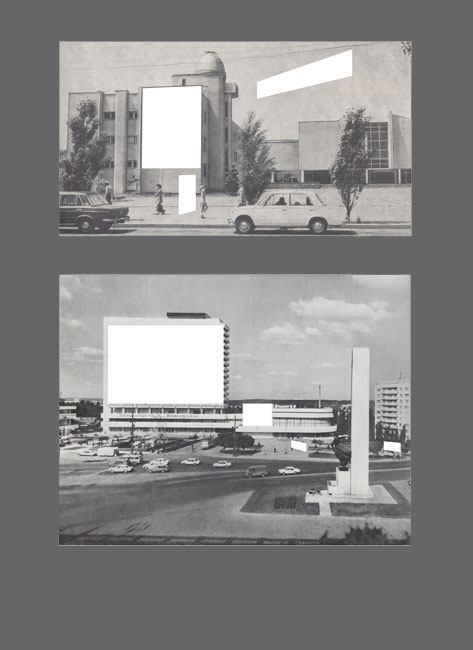
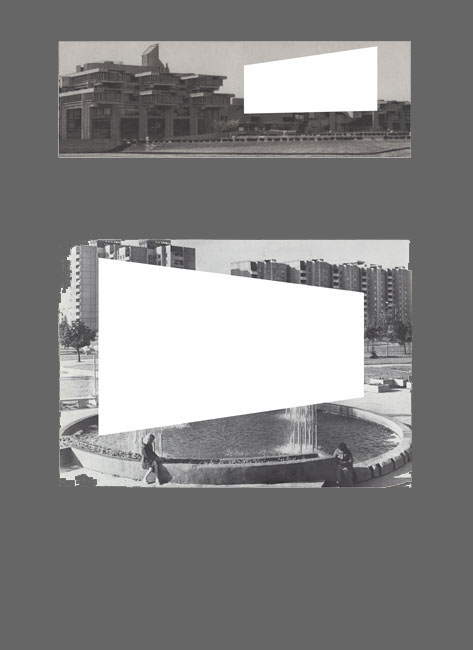
Catalogue of Opportunities, 60 x 45 x 9 cm, 2012, light boxes
The Catalogue of Opportunities consists of six light boxes with photographs of cityscapes from old Soviet architecture magazines. The artist transformed the original images by cutting out the parts of the buildings that nowadays are covered with commercial advertisement. The light from the boxes shines purely through the white parts of the photos.
The motivation behind the work comes from the artists’ awareness of the prevailing spirit of change in the post-Soviet society. This society has a young, energetic but brutal eager for the new, to such a point that all what is left from the past seems insignificant. As the artist states, ‘In a way the Soviet public sphere is helpless, it cannot protect itself from aggressive privatization such as the invasion of liberal commercial advertisements in the streets.’ What is left is a new pictural idiom, one that is put forward in disregard of the reminiscences of what is left of the past.
Surfaces
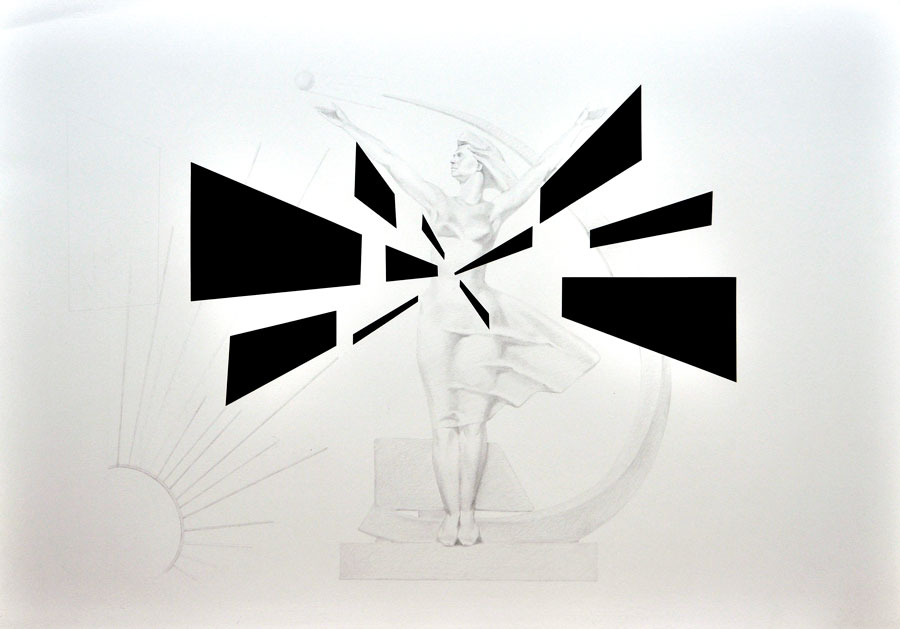
Surfaces | Monument, 70 x 100 cm, 2013, drawing & collage, private collection
In most of his works Nikita Kadan uses formal elements of early Russian avant-garde art. The references to the avant-garde idiom and esthetics are the most appealing in his series The Surfaces. The geometrical elements in the last room of the exhibition catch the eye from a distance. It seems like no logical order is given to the floating red, bleu and yellow shapes on the papers. Floating in space and on the walls they become independent shapes that occupy the room, similar to early Soviet avant-garde and Suprematist art.
If one comes closer to the drawings, one notices the thin pencil marks of buildings on the paper. What appeared to be mere abstract geometrical shapes are actually the gaps in the cityscape that are occupied by billboards and posters. Kadan abstracted them from their current position in the contemporary landscape into the esthetic tradition of the Soviet era.
The large drawing in the center room of the gallery also belongs to the Surfaces series and is composed in the same way as the smaller pieces. It represents one of the larger Soviet sculptures that Kadan saw in one of the metro stations in Kiev.
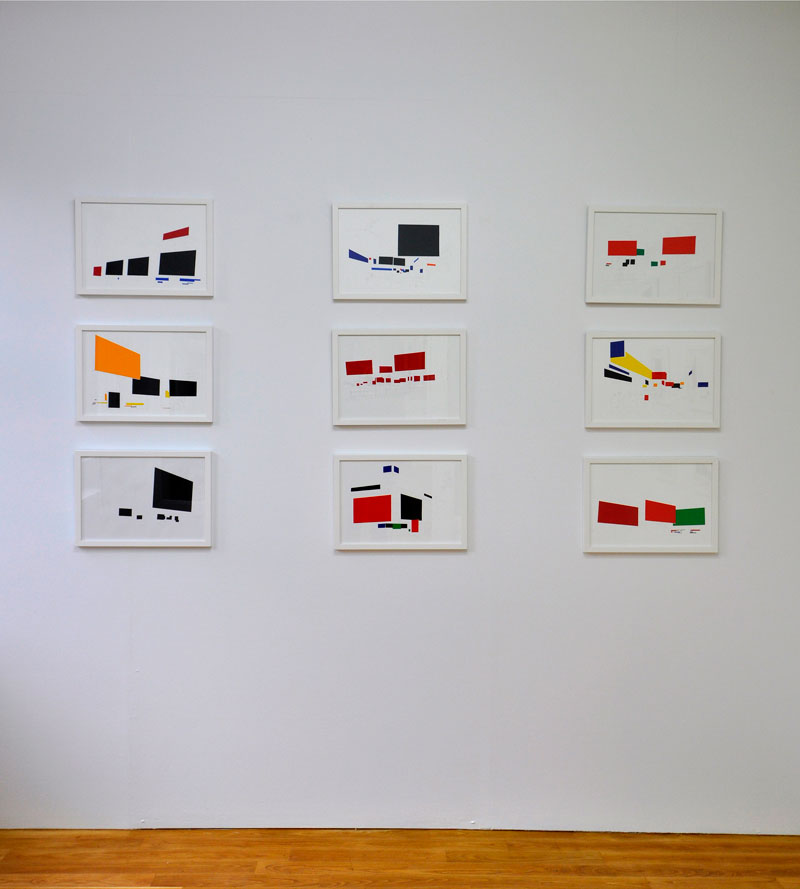
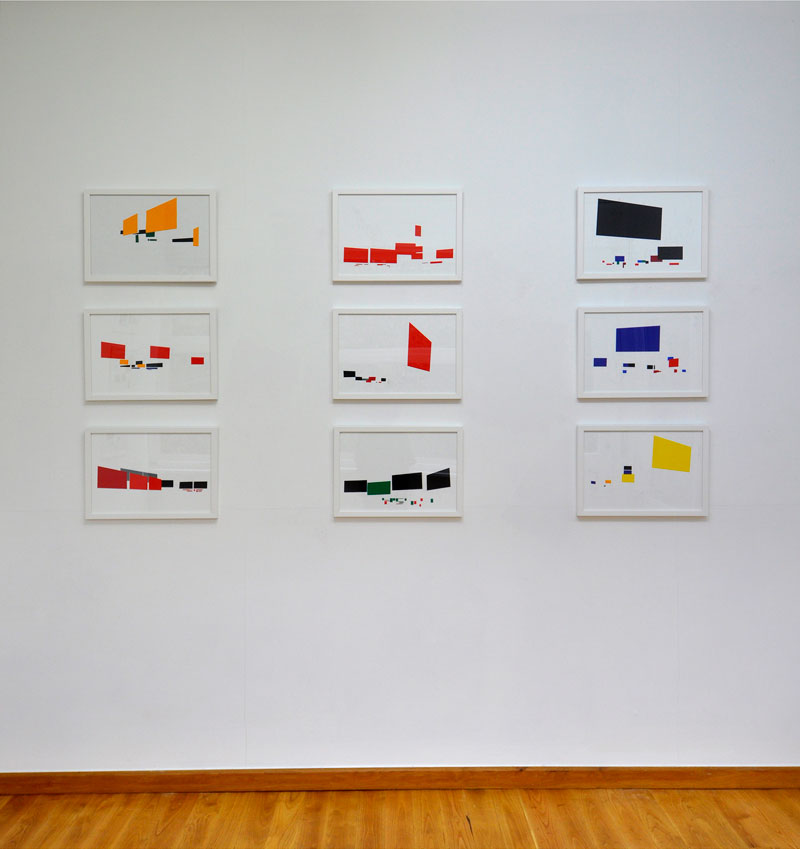
Yesterday, Today, Today

[installation, 2012]
The installation shows two showcases that are counter parted by a projection of recent photographs of the undergrounds in Kiev. This piece is another reflection on the contemporary post-Soviet society and the traces of her past in its own margins.
‘Built in the Soviet era, the Kiev metro system was, just like the Moscow metro, an ideological space, and stands in contrast to Western metro systems that are more or less exclusively utilitarian. It was conceived as a subterranean public pleasure dome, with vaulted-ceilinged halls, and decorations full of symbols. In the post-ideological time of the last two decades, the metro has joined the list of spaces opening themselves up to invasion by liberated commercial interests. Today the metro station halls have become advertising space, with the monumental scale of these former ideological palaces now serving competing advertisers. The stone of Soviet modernist antiquity is hidden behind self-adhesive film. The fact that the dormant ideological yesterday of Soviet granite and marble now carries constantly-renewing adhesive film with bright “It’s today, forever!” advertising seems to me like an image of rebellion against the future, one which angrily reflects our times and the places in which we live.’ [Nikita Kadan]
The black-white-red marble pieces, typical of the decoration of the metro, symbolize the buildings that are ‘overlapped’ by commercials. The vast material of the stones contrasts the short lifespan of the stick-on ads that are constantly renewed.
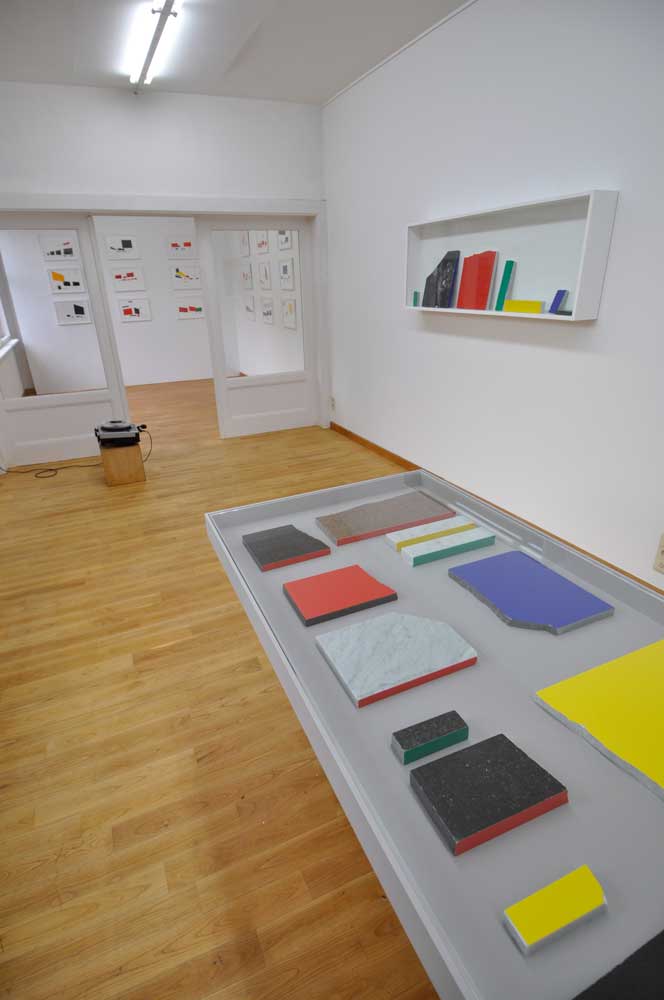
Transit Gallery presents “Procedure room”
This project is about police torture, a widespread practice in contemporary Ukraine. One could also say that this project is about the body, as something personal (unalienated), something private (an object of exchange), and as something that exists for the public good (entrusted to uniformed professionals). The project consists of a set of 8 souvenir plates printed with drawings of police tortures and the text of the email dialogue between Yekaterina Mishchenko and Nikita Kadan. The project includes posters with the same drawings and correspondence fragments, which were put up in public space. The choice of forms and visual means is connected with the absence of any clear visual documentation of torture procedures, with their specific 'invisibility'. The didactic character of these drawings addresses the collective responsibility of all those who know and remain silent, bearing the guilt for what goes on 'in the shadows'. These instructions have been executed in the style of the "Popular Medical Dictionary" of the Soviet era, where one could often find illustrations of patient-characters with serene facial expressions, even though they are undergoing extremely painful procedures. 'The doctor knows what he is doing. It's all for our own good'.








Procedure Room, diameter 28 x 8 cm, 2009-2010, ed 19/50, € 2.900 plus VAT
Pinchuk Art Center webpage about Nikita Kadan
read more on the artists own website
